Make a Canvas Sailboat Cover - I Made It at TechShop


Introduction: Make a Canvas Sailboat Cover - I Made It at TechShop

This instructable will go through the process to sew up a canvas sailboat cover. You can use the Industrial Straight Stitch or Walking Foot sewing machine available at TechShop Detroit. This is a cover that is for a 14 foot Collegiate FJ Sailboat. I made it at TechShop www.techshop.ws
Step 1: Cut Up the Existing Cover

For this project I had an existing boat cover available to take apart and copy. This is actually a project to create 6 covers for the Penn State University Sailing Club. They sent me back an old cover they had that was falling apart to use to make the new covers. To start with I noted down where all the snaps and fasteners are in a notebook and tried to note as well as possible how the parts went together, especially in the areas that go around the shrouds and mast. After that I used a seamripper to separate all the pieces. For this design, all the small pieces are rectangular strips. There are really only 3 main pieces that need to have patterns made.
Step 2: Make Patterns

To make the patterns, I used scrim pattern material available from Sailrite. www.sailrite.com. They are a good source for canvas making supplies and have many good how to videos available on their website. To make the patterns, I laid the 3 large canvas pieces onto a piece of scrim material and traced them out using a sharpie marker. I traced roughly half an inch larger around the parts to account for the seams. You don't need to be super accurate here since you will be sewing and the final product will have some variation no matter how careful you are here. Just be sure not to go too small. Too small and it may not fit at all. A little too big and it will still seem like it fits just fine. I used the workspace at TechShop Detroit to lay everything out to trace the patterns. The longer piece of this cover is 15 feet long and quite awkward to work around in a small home workshop.
Step 3: Cut the Large Pieces

I bought a large quantity of 8oz/square yard, navy marine use canvas on Ebay. You can find material that is useful for this purpose there for a fraction of the price of name brand Sunbrella which is what a canvas show will use to make this for you. For a DIY project, heavy canvas will be fine and hold up for years. Lay the patterns onto the canvas and trace them out. For marking on navy colored canvas I found the best thing was a "jelly" white permanent ball point pen I found at Micheal's arts and crafts. I have had no luck trying to use a soapstone pen which is always the recommended tool for this. The generic canvas usually has a top and bottom with one side coated so you need to be careful putting your patterns down so that the coated side is facing inwards in your finished product. Cut out the pieces using a pair of high quality scissors from a sewing supply store. Your hands will thank you verses using a set of cheapy scissors from Walmart. The material cut will be cleaner and take longer to fray.
Step 4: Sew It Together

For sewing this you can use the Industrial Straight Stitch or Walking Foot machine available at TechShop. I used a home heavy duty single stitch machine. It is borderline adequate for this job. A normal home machine will not work. Use a quality 18-20 size needle or you will be bending or breaking the needle constantly. Sew the 3 main pieces together first. Use a technique after sewing the first time called "top stiching" which is where you hold the seam down and sew back over it again. From there I sewed the bow and shroud snap edges. These are rectangular pieecs that are folded in half so that they are too layer and then sewed to the appropriate seem on the main pieces. Cut all the rectangular pieces extra long by 7 or 8 inches. Sew them on 90% of the way. Stop and fold and cut the excess off the rectangular piece, sew that seam and then finish sewing it to the main piece. This allows you to be much less precise with cutting out the smaller pieces and also allows you to not be super accurate when sewing around curved seams. I sewed the 2 zipper flap edges on. These are also again rectangles that are folded in half so they are double layer and sewn to the main pieces. Sew the zipper on. I use YKK zippers available from sailrite. In this case a 2 foot long fixed length locking zipper. Pay attention to make sure your zipper will be able to zip after you install it. I try to keep stitching around an 1/8 to 1/4 inch from the edge. If you get any closer to the zipper it may be difficult to zip it later on. When sewing on the zipper side with the pull, sew 5 or 6 inches of the zipper, you can then bury the needle, lift up the foot and you can pass the zipper pull under the foot to the area you've sewn already and then sew the remainder of the zipper on. Sew the edge skirting on. These are very long pieces. The bow sections in this case are 9 feet by 9 inches and the stern sections are 12 feet by 9 inches. For each of these I made a sub assembly by flipping the bottom seam up and sewing it and then sewing the 2 sides over. Sew these onto the main pieces. They will all be a foot or so too long. Shorten as we did for the other smaller rectangular parts. Sew a bungee cord into the bottom skirt. I used 1/4 inch bungee cord from Sailrite for this with bungee hooks and stainless steel rings. To start with you can sew one continuous piece into the bottom of the skirt. I folded the bottom skirt up about 2 inches to make the pocket for the bungee. Sew some small reinforcement pieces into the rear corners. This will help keep the corners of the boat from wearing through. Sew a reinforcement under the middle of the cover. This will be used to hold the cover up using a halyard so that water will flow off of it and not puddle on the boat. Sew a small piece of webbing onto the top in this area to clip the halyard too. Sew a small piece of velcro to the strip going around the mast. At this point you are finished with sewing and it's time to finish the bungee and add snaps
Step 5: Finish the Bungee

You will need to split the bungee at the bow and the 2 side shrouds. At each of these use a bungee hook on one end and tie a bungee ring onto the other end. Leave some extra bungee in all of these areas for now. You can tie more tension into the rings after the next step.
Step 6: Add Snaps

Add snaps at each shroud, at the mast and above and below the zipper. I used snaps available from Sailrite along with the tool to attach them. The tool is a small metal die and tap that you use to smash them in like rivets. There is an inexpensive plier like tool available from West Marine to attach these. It doesn't work well, don't waste your money on it. Either use the hammer tool or spend a lot to get the sailrite tool that looks like a large set of vice grips. Put a snap on the skirt where the bungee exists each part of the skirt. Put the snap as close to the bungee as possible. This will prevent the bungee hooks and rings from sliding into the skirt. After this you can tie the bungee cord so there is more tension.
Step 7: Put It on the Boat and See How It Fits
Try out the cover by putting it on a boat. From here you can adjust the bungee cord tension in the skirt so it fits nice and snug. After that your finished.
Recommendations

Make it Resilient

Engineering in the Kitchen - Autodesk Design & Make - Student Contest

Books and Bookshelves Contest

Marine News from the Great Lakes
Why diy making a winter sailboat cover.
Published: Sunday, April 18, 2021
A big question on every boater's mind at the end of sailing season is: Should I shrink wrap my boat or invest in a permanent boat cover? If you sew, why waste money every year on a temporary fix when you could sew your own long-lasting and durable canvas cover? Even if you've never sewn before, it's a solution still worth considering. DIY saves money and gives you self-sufficient skills you'll be able to use again and again both on the water and off.
Sailrite provides all of the materials and instructions you need to make a winter boat cover that will protect your boat for years to come. Need convincing? Just check out this list of reasons why shrink wrap is not the ideal solution for protecting your boat on the hard.

Reasons Not to Shrink Wrap Your Boat:
- A yearly expense . Shrink wrap will cost you money every year versus the initial cost to make a cover that will last for years, saving you hundreds of dollars in the long run.
- Moisture buildup and ventilation issues. Shrink wrap traps moisture under the plastic and could cause mold and mildew damage.
- Environmental impact. Shrink wrap generates piles and piles of plastic waste and can be difficult to recycle or dispose of properly.
- Access is difficult. If you have projects planned for the winter, getting inside your shrink-wrapped boat is difficult and costs extra. But it's easy to take a cover off!
- Potential hull damage. Shrink wrap can chafe and damage coatings such as Awlgrip and other painted finishes. There's nothing worse than unwrapping your boat and finding hundreds of dollars worth of unexpected damage.
Sailrite makes it easy to DIY a winter boat cover. Our free how-to video features thorough, step-by-step instructions on how to measure, pattern, cut and sew your cover. A complete materials and tools list makes it easy to order exactly what you need to get the job done. With Sailrite as your project partner, there's nothing you can't do.
Click here to watch Sailrite’s full video tutorial.
A version of this article appeared in the Spring Issue (Mar/Apr) 2021 of Great Lakes Scuttlebutt magazine.
tags: Boat Cover , Do It Yourself (DIY) , Environmental Impact , Shrinkwrap

Go back | Show other stories
Most Recent Related Video
Lake Erie Foundation
Browse Video Gallery
Keyword Search

Browse News by Region

Great Lakes

Lake Michigan

Lake Ontario

Lake Superior

Beyond the Lakes

Browse by Topic

Check the Map!

Check it out!
3 Cheap Ways to Make a DIY Frame for Your Boat Winter Cover
A boat frame is often used in conjunction with a winter cover to provide support and tension to the cover. However, buying a pre-made cover and frame can be expensive. Luckily, several cheap ways exist to make a DIY frame for your boat's winter cover.
One option is to use PVC pipes to create a frame for your boat cover. Another option is to use aluminum to create a sturdy, corrosion-free, and lightweight frame. If you prefer a traditional look, your third option is to use wood to create a boat cover support.
Ideally, you can also use metal as an alternative material to wood. It's more durable and requires little maintenance. However, it can have a higher initial cost than PVC, aluminum, or wood. If you've decided which material to go for, let's hop into how each of these frames is done, so you can get started.
- Building a boat cover frame from PVC pipes is popular due to its affordability and ease of customization, but it may not be as durable as other materials.
- Wood provides a traditional look and can be durable, but it requires more maintenance and may not be as long-lasting as other materials.
- Aluminum is lightweight and durable, but has higher costs (around $150–300) and is difficult to work with compared to other materials.
- Metal is a good alternative to wood as it is often more durable and long-lasting and can also be more cost-effective in the long run, but it has a higher upfront cost, around $200–$400.
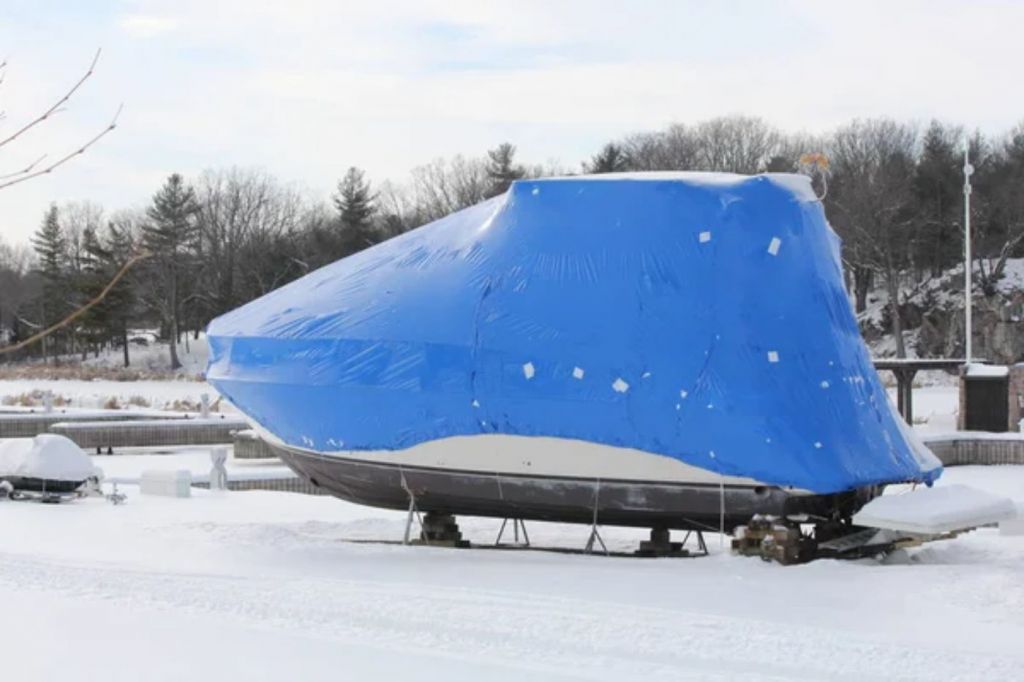
On this page:
Building a cheap winter boat cover frame, making a diy frame using pvc pipes, building a diy boat cover frame using wood, using aluminum to craft a diy boat cover frame, utilizing metal in making a diy boat cover frame, guide on how to make a sailboat winter cover frame.
The table below shows the pros and cons, as well as the estimated costs of building a DIY winter boat cover frame using different materials:
Planning your DIY boat cover frame
Now, before you start building your DIY boat cover frame, you need to plan it out carefully to ensure a successful project. Here are some tips to help you plan your DIY boat cover frame:
Take accurate measurements
Measure the length, width, and height of your boat, and make a note of any protruding features, such as a mast. This will help you determine the dimensions of your boat cover frame.
Decide on the type of frame
You can build a wooden frame, or use PVC pipes and fittings to create a boat cover support system. The latter is a cheaper and easier option, and you can easily customize it to fit your boat's dimensions.

Determine the number of straps needed
To secure your boat cover, you will need to attach straps to the frame. Determine the number of straps you need based on the dimensions of your boat and the type of frame you are building. You may need to drill holes in the frame to attach the straps.
Choose the right tools
To build your DIY boat cover frame, you will need a few basic tools, such as a drill, screwdriver, and saw. Make sure you have all the necessary tools before you start your project.
For a step-by-step process on how to build a boat cover frame , you can read this article.
PVC pipes are a popular choice for building a DIY boat cover frame because they are affordable and easy to work with.
Materials needed to make A DIY frame using PVC pipes
To build a PVC boat cover frame, you will need PVC pipes, elbows, connectors, a tubing cutter, a drill, and clamps. The cost of each is stated in the table below:
Steps in making a DIY frame from PVC pipes
- First, measure your boat to determine the size of the frame you need.
- Cut the PVC pipes to the appropriate length using a tubing cutter.
- Use elbows and connectors to join the pipes together to create the frame.
- Drill holes in the pipes where you want to attach the cover.
- Use clamps and bungee cords to secure the cover to the frame.
Advantages and disadvantages of a DIY frame made of PVCs
Advantages of using pvc pipes.
One of the advantages of using PVC pipes is that they are flexible and can be easily bent to fit the shape of your boat. This flexibility allows you to customize the frame to fit your specific boat shape and size, providing a snug fit and maximum protection from the elements.
Another advantage of using PVC pipes is that they are resistant to corrosion and rust, making them ideal for use in marine environments. They are also easy to clean and maintain, making them a cost-effective solution for building a boat cover frame.
Disadvantages of using PVC pipes
While there are several advantages to using PVC pipes for a DIY boat cover frame, there are also some disadvantages to consider:
Durability : While PVC pipes are resistant to corrosion and rust, they are not as strong as metal or wood. In harsh weather conditions, the pipes may bend or break, which can compromise the structural integrity of the frame and reduce its effectiveness in protecting your boat.
Weight : PVC pipes are lightweight, which can be an advantage when it comes to assembly and disassembly of the frame. However, this lightweight nature may also make the frame less stable in windy conditions and may require additional anchoring or weighting down.
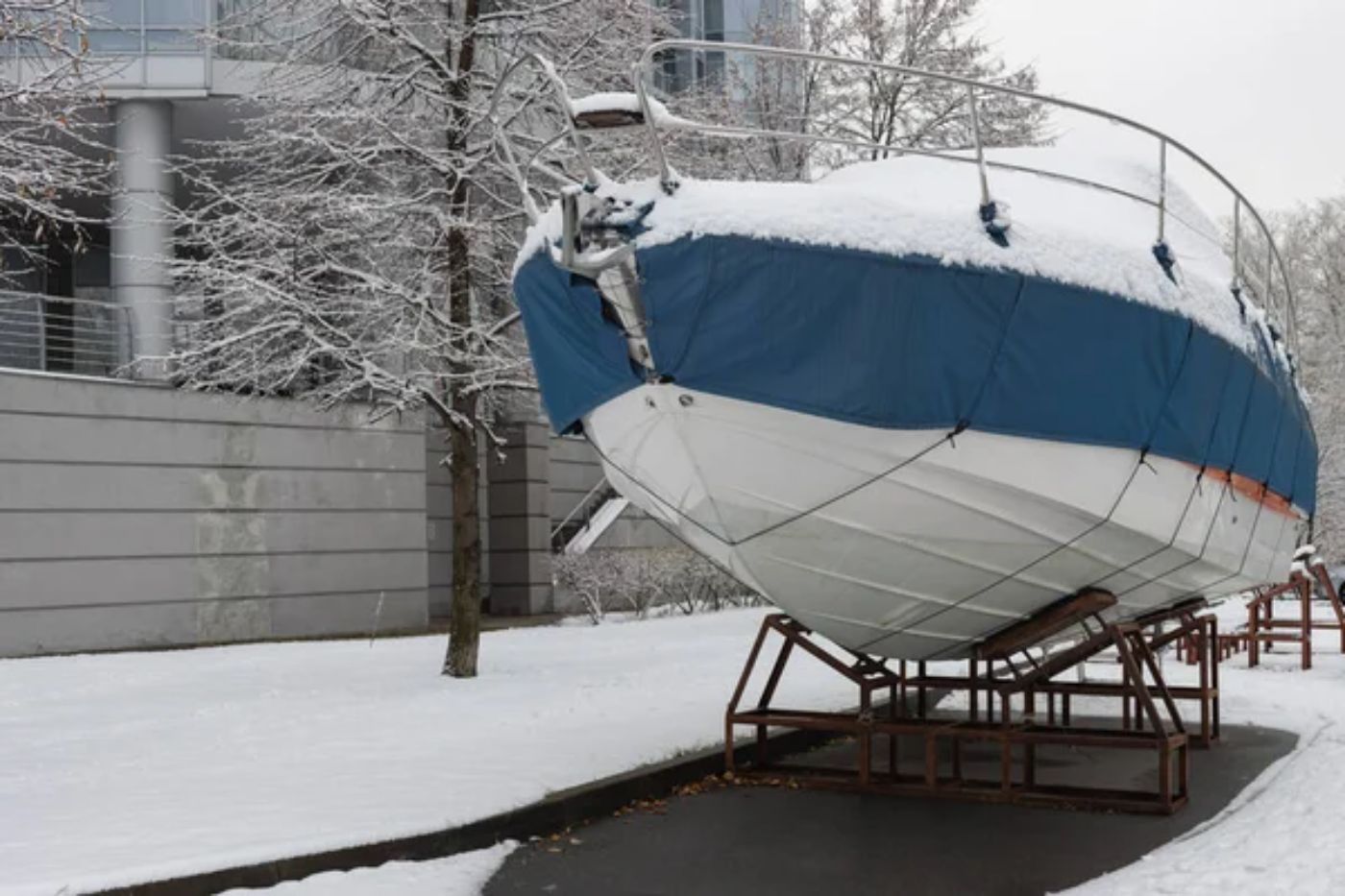
Aesthetics : PVC pipes may not look as aesthetically pleasing as other materials such as metal or wood. This may be a consideration if you want your boat cover frame to blend in with the surrounding environment or if you have strict aesthetic requirements.
Environmental impact : PVC is a type of plastic that is not biodegradable and can take hundreds of years to decompose. This means that if the pipes are not disposed of properly, they can contribute to environmental pollution.
If you prefer a more traditional look, you can build a DIY boat cover frame using wood.
Materials needed in building a DIY frame using wood
To build a wooden boat cover frame, you will need a saw, a hacksaw, a drill, screws, and plywood. The cost of materials is stated in the table below:
Steps in building a DIY frame out of woods
- Measure your boat to determine the size of the frame you need.
- Cut the wooden boards to the appropriate length using a saw.
- Use a hacksaw to cut holes where you want to attach the cover.
- Join the boards together to create the frame using screws.
- Attach the cover to the frame using clamps and bungee cords.
Pros and cons of using wood as a boat cover frame
Pros of using wood.
- Cost-effective : Building a wooden boat cover frame is typically more affordable than purchasing a pre-made frame.
- Customizable : You can customize the size and shape of the frame to fit your specific boat and needs.
- Durable : A well-constructed wooden frame can be sturdy and reliable, providing long-lasting protection for your boat.
- Easy to repair : If any part of the frame becomes damaged, it can be easily repaired or replaced with new wood.
Cons of using wood
- Time-consuming : Building a wooden boat cover frame can be a time-consuming process, especially if you're not experienced with woodworking.
- Requires tools : You will need access to certain tools such as a saw, drill, and hacksaw to build the frame, which may require an additional investment if you don't already own them.
- Requires regular maintenance : Wood can be susceptible to rot and damage from moisture, so you might need to take steps to maintain the frame and prevent these issues.
- Limited lifespan : While a well-maintained wooden frame can last for several years, it may not be as long-lasting as other materials such as metal or PVC.

Aluminum is a lightweight and durable material that is resistant to corrosion and rust, making it a popular choice for boat covers.

What's the Best Material for Winter Boat Covers?
Materials required to build an aluminum boat cover frame.
To build an aluminum boat cover frame, you will need to purchase aluminum tubing, connectors, and fasteners. You will also need a saw, a drill, and a measuring tape to cut and assemble the frame. The cost of each one can be found in the table:
Steps to craft a DIY frame from aluminum
- Cut the aluminum pipes to the appropriate length using a tubing cutter.
- Join the pipes together to create the frame using screws.
Benefits and drawbacks of using aluminum as a DIY boat cover frame
Benefits of using aluminum.
- Lightweight : Aluminum is a lightweight material, which makes it easy to handle and install.
- Durable : Aluminum is resistant to corrosion and rust, which means that it will last longer than other materials such as wood or PVC.
- Low maintenance : Aluminum requires minimal maintenance, making it a convenient option for those who want to spend less time maintaining their boat cover frame.
Drawbacks of using aluminum
- Cost : Aluminum is typically more expensive than other materials such as wood or PVC, which may make it a less affordable option for some people.
- Difficult to cut and assemble : Aluminum can be more difficult to cut and assemble than other materials, especially if you don't have experience working with metal.
- Limited lifespan : While aluminum is durable, it may not be as long-lasting as other materials such as steel or PVC.
- Conducts heat : Aluminum can conduct heat, which means that it may become hot to the touch in direct sunlight.
If you're looking for an alternative to wood, metal can be a great option for building a DIY boat cover frame. Metal is often more durable and long-lasting than wood, and it can also be more cost-effective in the long run since it requires less maintenance and is less likely to need repairs or replacements.
Materials for building a DIY frame using metal
To build a metal boat cover frame, you will need a saw, a drill, screws, metal tubing, metal connectors, and a metal cutting blade. The cost of materials is stated in the table below:
Steps in building a DIY frame using metal
- Cut the metal tubing to the appropriate length using a metal cutting blade.
- Use metal connectors to join the tubing together to create the frame.
- Use screws to secure the connectors and tubing together.
Pros and cons of using metal as a boat cover frame
Pros of using metal.
- Durable : Metal is often more durable and long-lasting than wood, making it a great option for a boat cover frame.
- Low maintenance : Metal requires less maintenance than wood and is less likely to need repairs or replacements.
- Easy to repair : If any part of the frame becomes damaged, it can be easily repaired or replaced with new metal tubing.
Cons of using metal
- Higher upfront cost : Building a metal boat cover frame can be more expensive upfront than building a wooden frame.
- Requires tools : You will need access to certain tools such as a saw, drill, and metal cutting blade to build the frame, which may require an additional investment if you don't already own them.
- Heavier : Metal is generally heavier than wood, which may make it more difficult to transport and maneuver.
- May develop rust : Depending on the type of metal you use and how well you maintain the frame, it may be susceptible to rust and corrosion over time.
A sailboat winter cover frame is a structure that is used to support a winter cover over a sailboat during the cold months of the year. The frame is typically made of metal or PVC pipes and is designed to fit the specific dimensions and shape of the sailboat.
The winter cover is then draped over the frame and secured in place to protect the boat from snow, ice, and other harsh weather conditions. The frame provides support for the cover and helps prevent it from sagging or collapsing under the weight of snow and ice.

How to Winterize Your Sailboat Cheaper & Quicker
To make a sailboat winter cover frame, you will need the following materials:
- Metal or PVC pipes (1-2 inches in diameter)
- Pipe connectors (T-joints, elbow joints, etc.)
- Measuring tape
- Hacksaw or pipe cutter
- Drill and screws (if using metal pipes)
- Rope or bungee cords
- Winter cover
Step-by-step process to create a sailboat winter cover frame

Measure the length, width, and height of your sailboat to determine the size of the frame you will need.
Cut the metal or PVC pipes to the appropriate lengths using a hacksaw or pipe cutter.
Assemble the pipes and connectors to create the frame. Use T-joints to connect the pipes that will form the base of the frame and elbow joints to create the corners.
If using metal pipes, drill holes in the connectors and attach the pipes using screws to secure them in place.
Once the frame is assembled, drape the winter cover over it and secure it in place using rope or bungee cords.
Make sure the cover is tight and secure, with no sagging or gaps that could allow snow or ice to accumulate on the boat.
Check the frame and cover periodically throughout the winter to ensure they remain secure and in good condition.
Leave a comment
You may also like, the complete checklist for winterizing your boat (free pdf).
More than twenty years ago, when I bought my first boat, I didn't have a clue about a lot of things. As the first sailing season was winding down, a friend asked me …

How to Winterize Your Sailboat Cheaper & Quicker
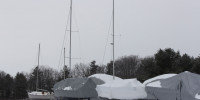
The Average Cost to Shrink Wrap a Boat (per foot)

The Real Cost to Winterize Your Boat on a Budget
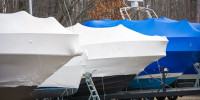
Pros and Cons of Shrink Wrapping a Boat - Worth It?
Own your first boat within a year on any budget.
A sailboat doesn't have to be expensive if you know what you're doing. If you want to learn how to make your sailing dream reality within a year, leave your email and I'll send you free updates . I don't like spam - I will only send helpful content.
Ready to Own Your First Boat?
Just tell us the best email address to send your tips to:
25 Homemade Boat Cover Ideas You Can DIY Easily
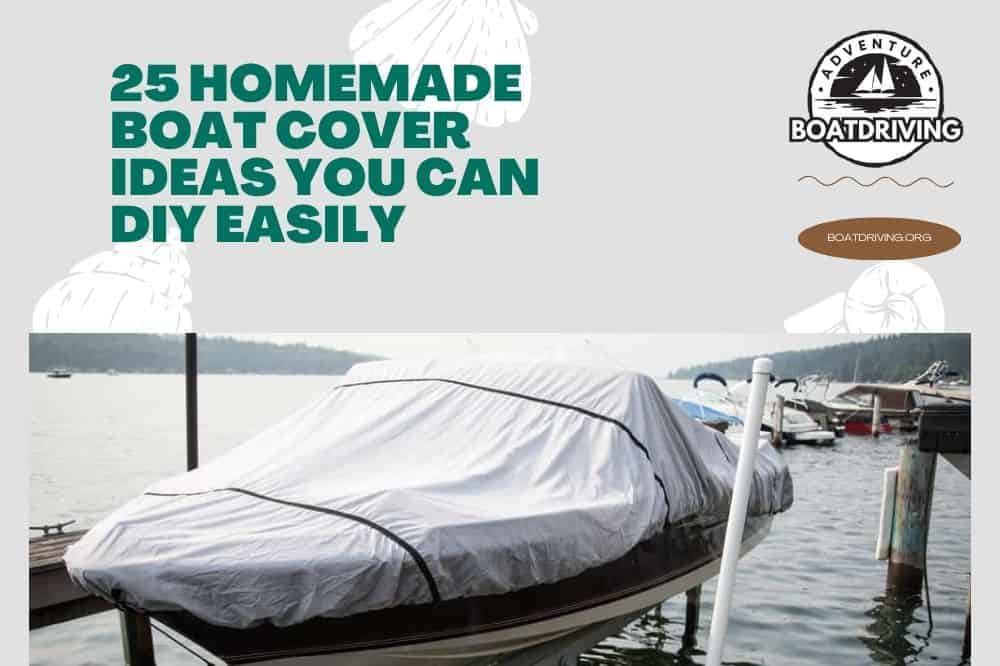
Boats are expensive, so it’s worth the effort of making sure yours is properly protected when you’re not using it, but unfortunately, even the covers themselves don’t come cheap. However, there is a solution that will save you some money, and that’s to make your own.
For anyone who wants to have a go, we’ve scoured the internet to see what other people have been trying – and as a result, here’s a selection of the best DIY boat cover plans you’ll be able to copy yourself.
Table of Contents
1. How to Make a Boat Cover – Boatsafe.com
2. how to make a power boat cover, 3. do-it-yourself: fashioning canvas covers for your boat – passagemaker, 4. best diy boat cover support system, 5. making a new boat cover for my skerry – christinedemerchant.com, 6. boat cover diy, 7. how to make a powerboat cover – sailrite, 8. how to make sunbrella dinghy cover to protect pvc from sun uv, 9. how to make a boat cover – doityourself.com, 10. easy cheap boat cover support frame diy, 11. homemade boat cover support system – ourrecipesforsuccess.com, 12. diy boat cover, 13. make a canvas sailboat cover – i made it at techshop: 7 steps – instructables, 14. how to fix a boat cover that gets filled with water, 15. diy: small boat cover frame – bound to journal, 16. how to build a tarp frame for a boat, 17. diy canvas repair tips – boating magazine, 18. how to make a trailerable boat cover, 19. how to make a homemade pontoon boat cover support system, 20. cheap and easy boat cover frame – how to diy, 21. diy tarpaulin for your yacht: a low-cost alternative, 22. make your own winter boat cover, 23. secret tarp hacks, 24. our diy boat cover – adventures on the club, 25. diy retractable boat cover, plenty of great options for diy boat covers.
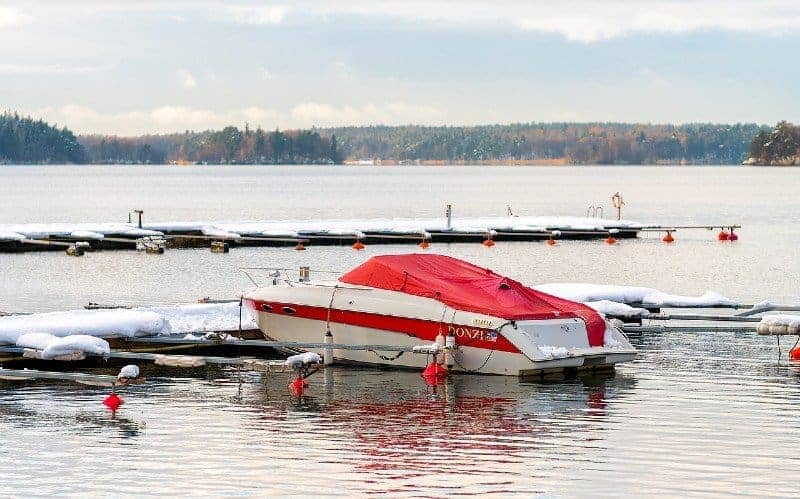
As this post explains, providing your boat with a good-quality cover is important for protecting it, but since boats come in all shapes and sizes, it can be hard to find the right one for a reasonable price. The alternative is to make one yourself, and this blog post tells you all about how to do it, with details on the materials you’ll need as well as a step-by-step guide to completing the project. A well-written post and well worth a look.
Check More Details
The written introduction to this video tutorial tells you it will teach you how to make a custom cover for your powerboat, and if that’s what you need, it’s recommended watching. At well over an hour, it’s a long video, but that means it goes into plenty of detail to help ensure your project is successful and the cover you make is a perfect fit for your boat.
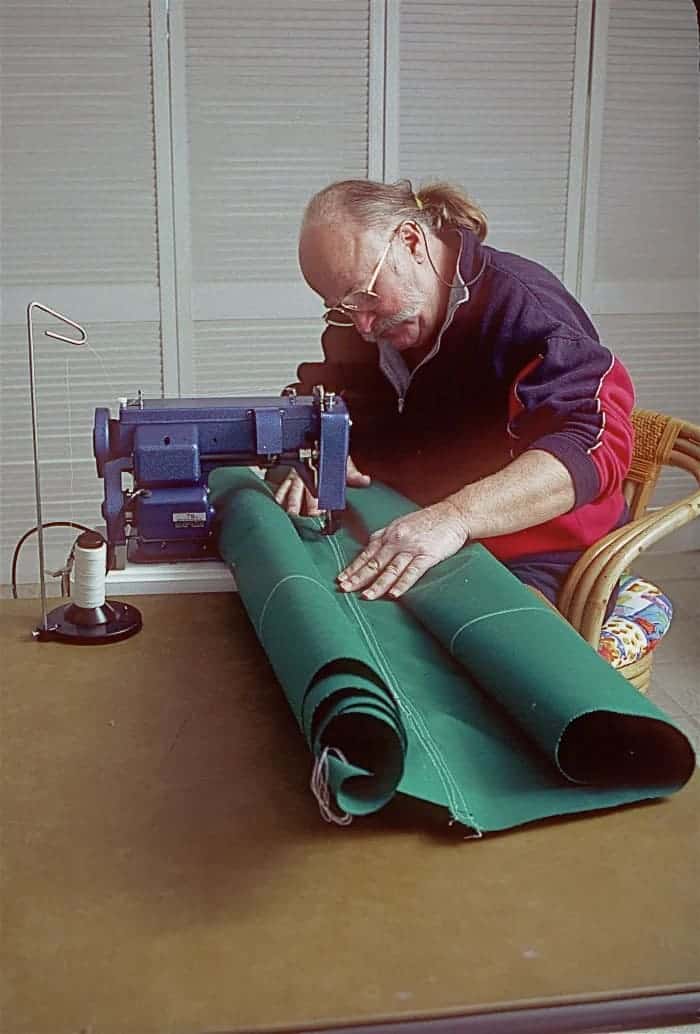
Sewing is a handy skill for any seafarer to be acquainted with – for example, you never know when you might need to make running repairs to your sails while on the ocean. However, even on dry land, those skills can be put to use if you want to make your own DIY cover to keep your boat safe. It’s not such a difficult job, and with the right equipment and a bit of determination, anyone can do it – and this blog post will teach you how.
If you want a cover for your boat, you may also need a support system to hold it in place. That’s what this tutorial is about because in it, this YouTuber shows us how he built a frame to hold the cover for his Jon boat . The frame is made of PVC pipes, and the tarp itself cost only $20 – so as you can imagine, the whole setup was extremely inexpensive. And if you want something similar, it should be easy enough to copy his plan at home.
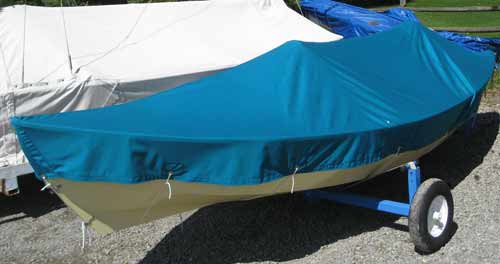
In this post, this blogger tells us about how he designed and made a new cover for his skerry. As he explains, his previous tarps only lasted around two seasons each, and this time, he wanted something a bit more durable. He gives us a clear description of what he did and also provides plenty of photos, so if you need something like this, why not have a go at making one yourself?
This video gives you a basic method for making a cover for your boat using just a simple tarp. If you only have a small boat and don’t need elaborate solutions, sometimes it’s best not to overcomplicate things – and if that sounds like the kind of project you want to try, this is the video for you.
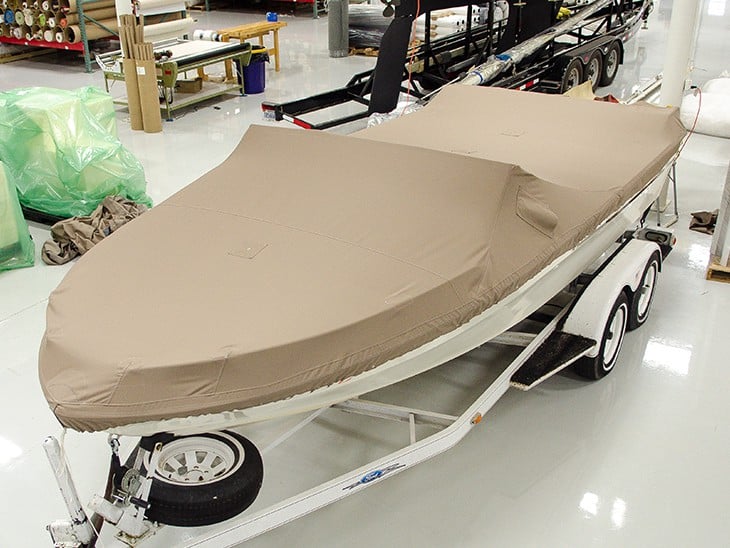
The homemade cover protecting the powerboat in the photo looks highly professional, and as the post promises, you’ll also find plenty of helpful tips, techniques and step-by-step instructions for making a snug version just like it for your boat. It even includes a video showing how to do it, making this a great resource for anyone interesting in making a DIY boat cover.
In this video, you’ll learn how to make a cover to protect a dingy from UV damage. Dinghies are not usually made of particularly UV-resistant material, so it’s important to cover them up. Buying a cover can cost around $800, but with this plan, you can make one for much less, saving you a whole lot of cash.

There are several benefits of making a cover for your boat rather than buying one, as this blog points out. You can save money, and importantly, one you make yourself will probably be a much better fit for your boat. It’s also not that difficult to do, and this post takes you through how to complete the job in just eight simple steps.
Like #4, this video tutorial shows you how to build a cover frame that will help keep rainwater out of your Jon boat . It’s another simple and inexpensive design based on PVC piping, offering an easy and affordable way to protect your boat from the elements.
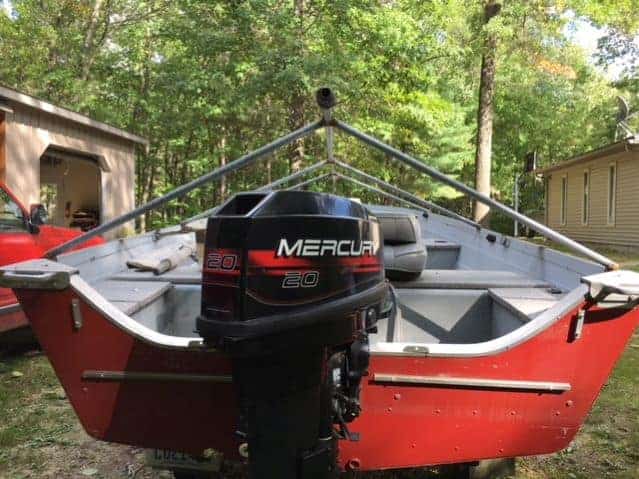
This is another plan for a boat cover support, but this one is for something a little more substantial since the frame is made of metal. That means there’s a little bit of welding involved, but if that doesn’t put you off, it’s an easy enough job – so why not see if you can replicate it at home?
Here we learn about a simple technique for fitting a tarp to a duck-hunting boat. As this YouTuber explains, just covering his boat with a tarp would result in a sag in the middle where water would collect. His solution was to rig up a DIY frame to create a ridge – and his idea worked perfectly. Check out his video and see what you think.
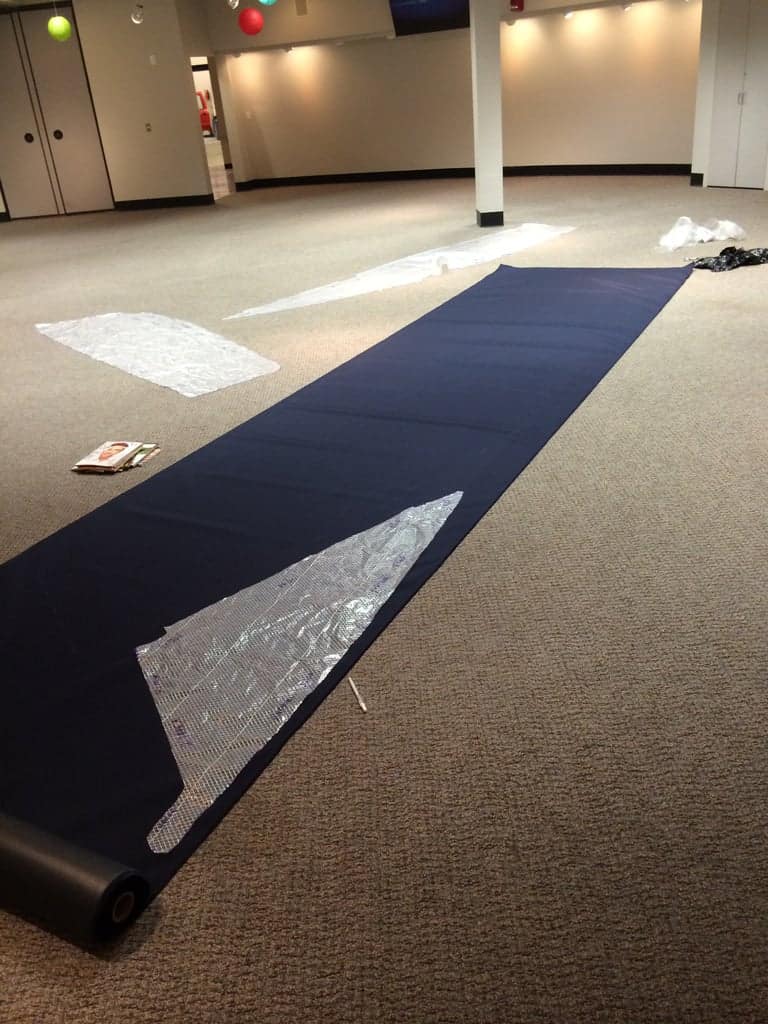
Making a DIY cover for a sailboat is among the more challenging types to attempt, but with the right plan, it’s far from impossible. This tutorial takes you through how to do it in a clear and logical order, and it also provides you with plenty of photos for reference. Plans from this site are always high quality, and this is another one that doesn’t disappoint.
For anyone fed up with water pooling on their boat cover when it rains, this is a useful video to watch – because in it, you’ll find out about a super-simple but highly efficient solution to your problem. Sometimes the simplest ideas are best, and this video is the proof. Great job, we enjoyed this one!
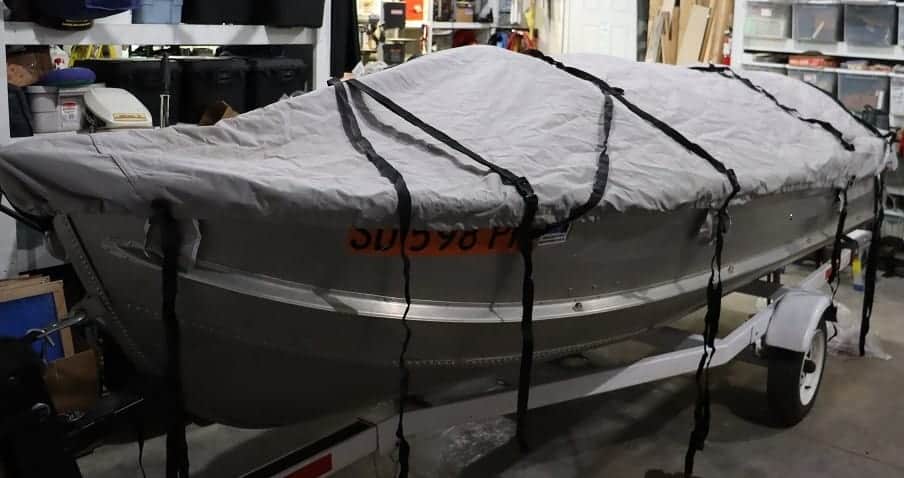
This blog recounts a common problem that many boat owners probably recognize – namely, water pooling inside the boat after snow or rain due to the cover sagging. The simple solution is to build a frame that allows the water to run off over the side – and the included video teaches you how to make one.
The YouTuber in this video seems to have quite the dry sense of humor, but he also has lots of great ideas about how to build a frame for your boat cover . So if you want to find out how to do it – and you don’t mind a joke or two along the way – this is a video you should enjoy.
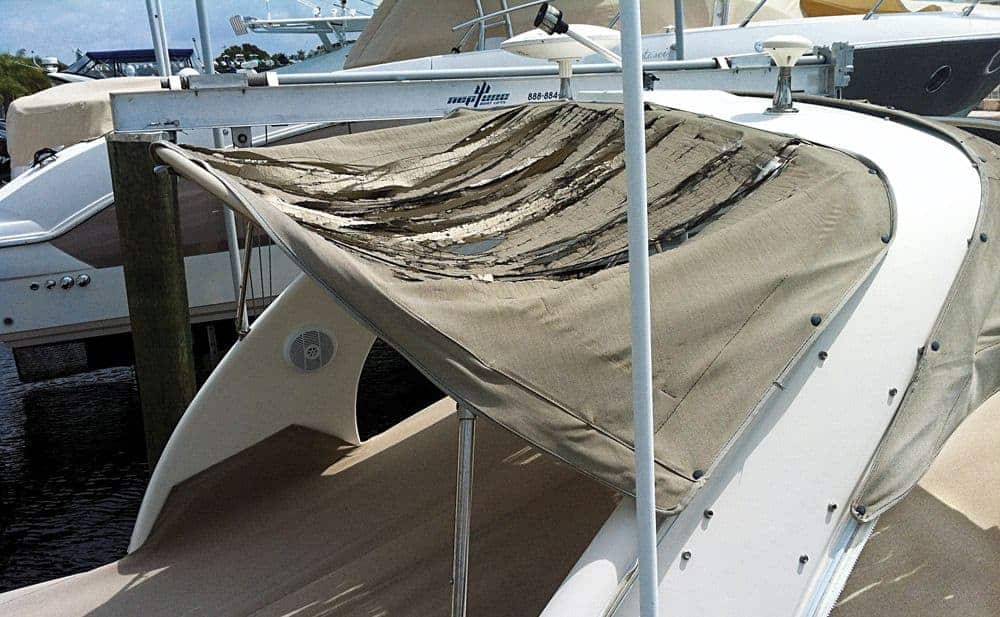
If you already have an old boat canvas and don’t want to spend the money on buying a new one, you can DIY one – or you can DIY-repair the one you already have. The second option can save you both time and money and can also allow you to put off buying a new one for at least couple of years. Sound like something you might be interested in trying? Then give this post a read!
This is a long and detailed video from the same people who made #2, and just like that offering, it’s a high-quality tutorial. This one teaches you how to make a trailerable boat cover, and if that’s what you need, there are few better videos online for you to watch.
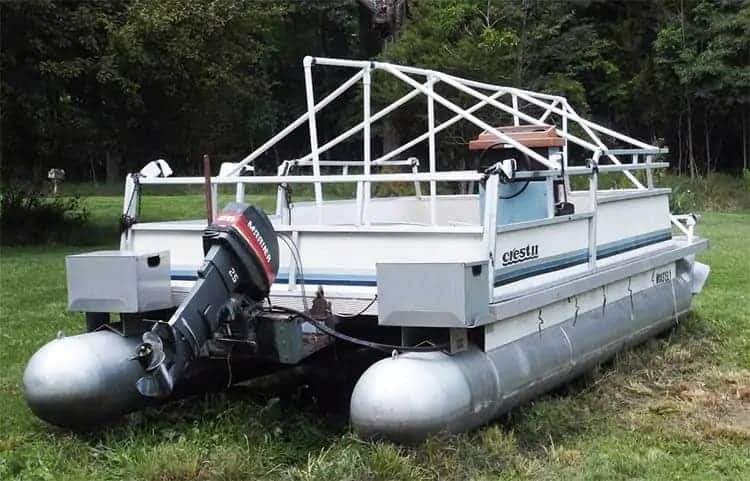
This is another plan that teaches you how to make a boat cover frame, this time for a pontoon boat . As the blogger explains, there’s nothing more frustrating than coming back to your boat and finding it full of water or even critters – and this plan will show you how to prevent that from happening.
The cover frame this video teaches you how to make is intended for bass boats , but as we are told, it would be easy to modify the design to fit other types of boat too. It’s an easy and cheap method that anyone can copy, and it works perfectly too – so what are you waiting for?
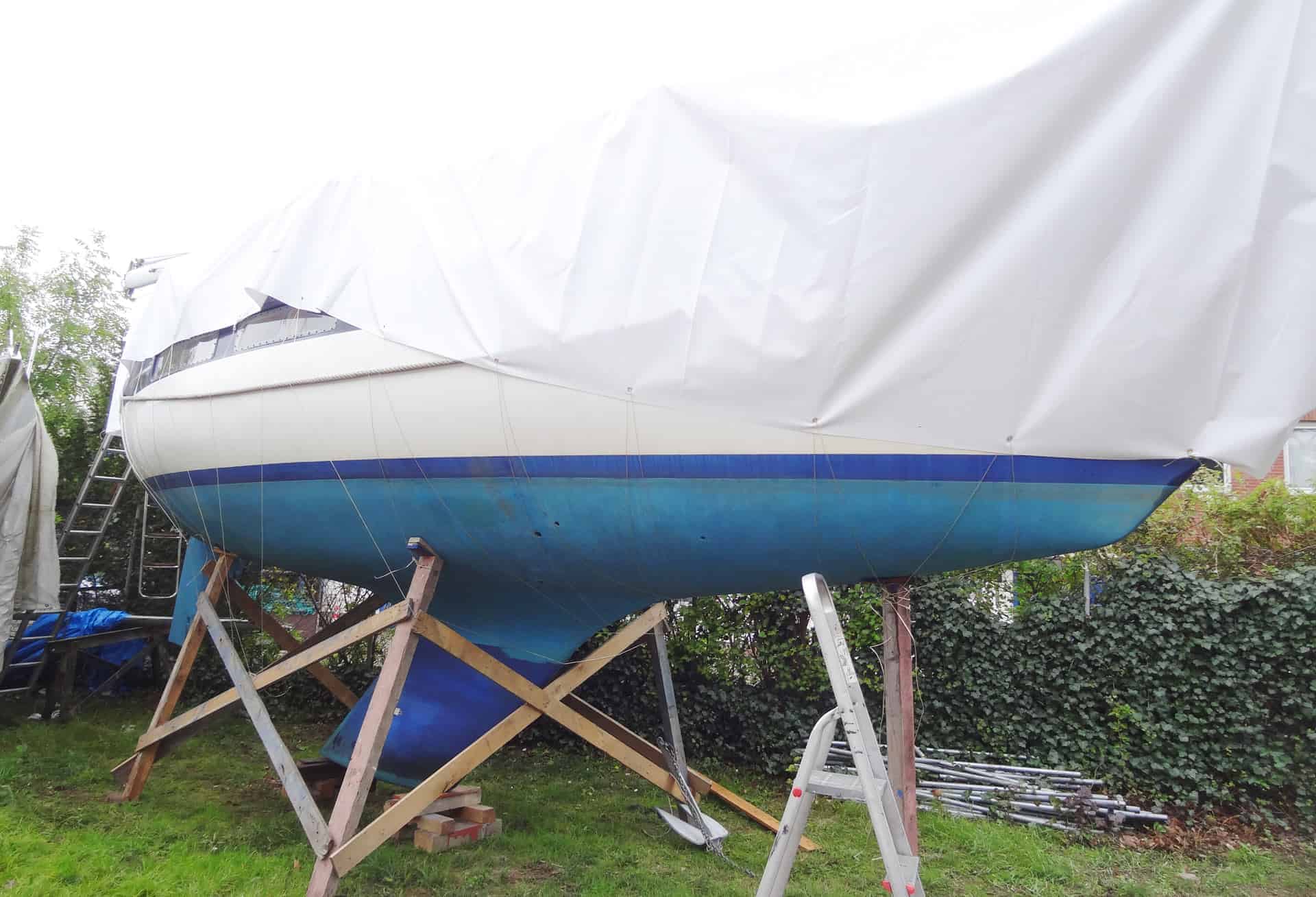
When it comes to storing your yacht through the winter, there are lots of factors to consider, but in almost all cases, you’ll need a reliable tarp to protect it. This blog post talks in detail about the best options for boat storage available to you and tells you how and why this blogger decided to make a DIY version – so if you’re facing similar decisions, it’s well worth checking out.
Here’s one more video from the same people who made the videos in #2 and #18 – and just like those tutorials, this one is long and full of invaluable information. This upload is about making a winter boat cover, and if that’s what you’re interested in, you’d do well to watch this video all the way through.
This video is another one from the YouTuber who gave us #16, and in this video, he shares all the tips and tricks about tarping boats that he’s accumulated through years of experience. That means it doesn’t give you a specific plan to follow, but it does give you plenty of useful info – which makes it worth a look before you start planning how to make a DIY tarp or boat cover of your own.
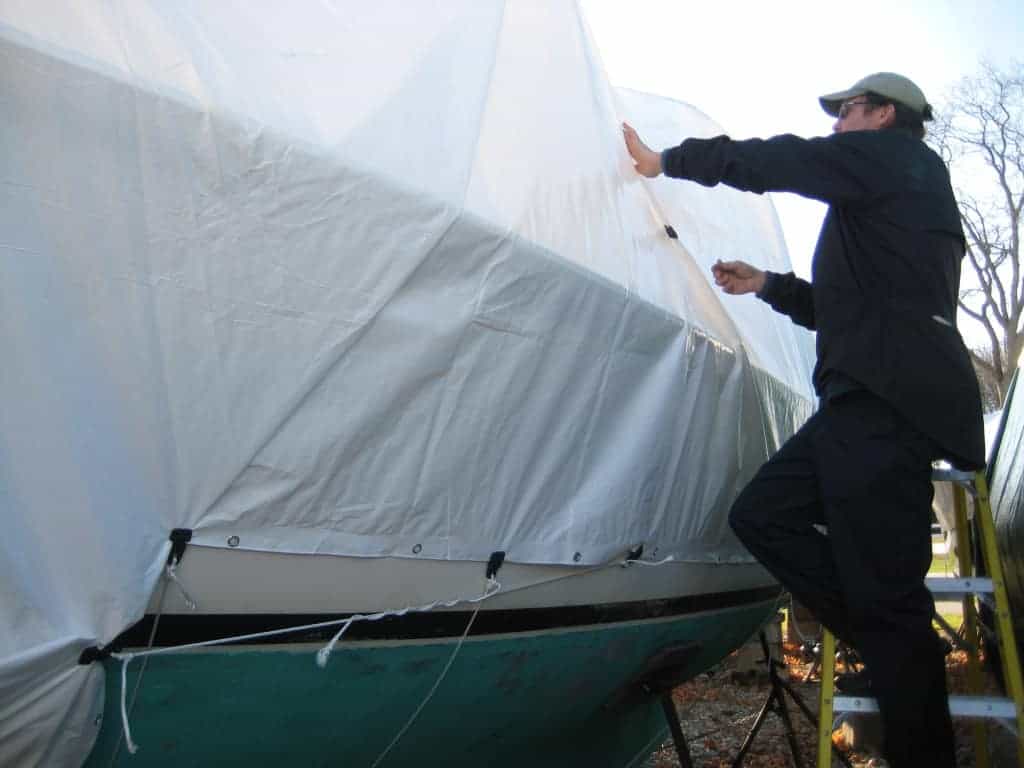
The retractable cover this YouTuber made for his dive boat cost only around $125, making it an effective yet affordable solution to the problem of protecting his vessel. As he explains, without the cover, his boat was constantly being filled with pollen, pine needles and a whole lot more, but by utilizing the trees around where he stored the boat, he was able to rig up a DIY solution. It works perfectly too, so check it out if you think you might want to copy some of his ideas.
As you can see, whichever type of vessel you own, there are plenty of great plans for making a DIY boat cover that will help keep your boat protected and safe while also saving you a bit of money.
We’ve enjoyed collecting these plans for you, so we hope you’ve enjoyed watching and reading them too. And above all, we hope we’ve helped you find the ideas you needed to get started on a DIY boat cover of your own.
Related posts:
- 18 Homemade Wood Boat Plans You Can DIY Easily
- 18 Homemade Boat Trailer Plans You Can DIY Easily
- 17 Homemade Boat Lift Plans You Can DIY Easily
- 17 Homemade Boat Motors Plans You Can DIY Easily
3 thoughts on “25 Homemade Boat Cover Ideas You Can DIY Easily”
The bottom of my 2000 Logic is coming apart at the bottom of the transom. I heard there was an issue with this. What are mr recourses ?
Budget is another consideration and the good thing is that I’ll find an affordable and effective one. Mypontoon still needs protection even if it’s in storage.
thanks for the useful information. pontoon boat covers to protect it from the harmful rays of the sun which contain UV rays. budget and quality of cover are very important
Leave a Comment Cancel reply
Save my name, email, and website in this browser for the next time I comment.
- View Full Site
- Advertising
- Cookie Policy
- Privacy Statement
- Terms of Service
- Cars, Trucks & Boats
- Boating & Sailing
- Boat Repairs
How to Make a Boat Cover
- Written by Dustin Camilleri on Jul 26, 2010 To ensure our content is always up-to-date with current information, best practices, and professional advice, articles are routinely reviewed by industry experts with years of hands-on experience. Reviewed by H.R. Helm on Dec 10, 2019
Making a boat cover does not entail much work, but the benefits it proposes are numerous. Hence, it is a good idea to learn how to make your own. You might opt to buy a ready-made boat cover, but it may not be of a very good fit for your specific boat, not to mention that the cost of purchasing it will inevitably surpass the money involved in making one yourself. Besides, you can be as creative as you wish and choose a material and color you prefer. Read through these basic tips and steps and give it a try.
Step 1 - Measure the Boat
First of all, you have to measure your boat. Start with measuring the stern at its highest point, on the stern itself or the rail if there is one. In the event that there is a stern rail on your boat, you’ll want to take a quick measurement of the height from this piece down to the rub rail at the edge. This way, you can account for the extra height you’ll need in order to cover it. Create a rough sketch of the top of your boat so you can note your measurements right on the diagram.
Next, measure the overall width of the windshield and the height from its peak to the rub rail once more. Then, do the same thing for the widest part of the bow, measuring height to the rub rail again if there’s a railing there.
Finally, take one last measurement from the bow rub rail to the stern rub rail, from end to end. Drape the measuring tape over any high points, like railings and the windshield for an accurate measurement. More information can be noted about the specific dimensions of your boat if you want to get the tightest fit, but for an easier project, this should suffice.
Make sure you record all measurements accurately to ensure a good fit for your boat cover. You do not want the cover to be too tight as it might easily flip over and fail to cover the boat well. However, you do not want it to be too loose either as it might allow water and other dirt to get into the boat.
Step 2 - Purchase the Materials Needed
The best types of materials for making a resistant boat cover are hard plastic or heavy canvas . To purchase enough material according to your boat’s dimensions, use your total end-to-end measurement and divide it by the width of your fabric bolt. This will give you the number of panels you’ll need in your cover. Then, for the total length of the fabric you need to buy, take the measurement of your boat at its widest point and multiply that by your number of panels. You may need to add about five percent to this total just to be sure you have enough fabric.
Step 3 - Cut the Material
At this point you can start cutting out the material. Be as accurate and precise as possible while bearing in mind to add an allowance in order to stretch the cover below the sides of the boat and make any necessary ties which will keep it stretched and tightly fitted.
Each panel has been calculated to fit widest segment of the boat, so panels laying across the other, thinner points will need to be trimmed to the appropriate length after you finish stitching the cover together and doing a drape test on the boat.
Step 4 – Stitch Panels Together
Lay each cut panel over the boat, overlapping the edges with a 5/8-inch seam allowance to test that the cover will fit as it’s supposed to. If everything checks out, go ahead and stitch the seams between the panels, pressing them flat on the inside and overcasting the raw edges if you’re using canvas.
Drape the sewn cover over the boat once more, making it as even as possible on both sides. Now, use marking chalk to note places where the edges need to be trimmed for a consistent, even length all the way around. Then, make some quick cuts as needed before you continue.
Step 5 - Punch Holes on the Sides or Sew
Afterward, punch holes on the sides of the cover. The holes need to be wide enough to allow the rope to pass through without problems. For extra protection on the holes, to prevent them from ripping , see if you can find some industrial-sized grommets to cover them with, such as those used on shower curtains.
Alternatively, if you are going to use canvas or some other type of fabric, you may opt to fold the sides by about five inches to create several pockets for threading drawstrings. Don’t forget to leave two open ends right next to one another for the drawstring to enter and exit.

Step 6 - Insert the Ropes or Drawstring
Insert water-resistant ropes through the holes, or if you chose to sew pocket linings, you can thread a drawstring through.
Step 7 - Lay the Cover On the Boat
Lay the cover on the boat carefully and adjust it in such a way that the whole boat is evenly covered all the way round.
Step 8 - Pass the Ropes or Drawstring Beneath and Knot
Make sure you have enough excess rope or drawstring to pass the ends beneath the boat. Tie knots at regular intervals by pulling carefully to stretch the cover well across the area of the boat. The number of knots will depend on the size of the boat. To ensure a good job, it is best to have someone help you out at this point.
Making your own boat cover can be very satisfying and by following these guidelines you will certainly succeed in doing a good job.
Related Posts
Popular articles.

- our experts
- terms of use
- privacy policy
- cookie policy
DoItYourself.com®, founded in 1995, is the leading independent home improvement and repair website. We welcome your comments and suggestions. All information is provided "AS IS." Website operating problems contact [email protected] . Questions of a Do It Yourself nature should be submitted to our " DoItYourself.com Community Forums ". Copyright© 1995-2024 MH Sub I, LLC dba Internet Brands. All rights reserved. You may freely link to this site, and use it for non-commercial use subject to our terms of use . View our Privacy Policy here .
- Pontoon Boats
- Personal Watercraft
- nauticalknowhow
- Nautical Knots
- Tools and Calculators
How to Make a Boat Cover
You should never underestimate the importance of a boat cover. A good boat cover will protect your boat from dirt and debris. Not to mention wear and tear from the sun and the rain. And of course it can protect from dings and scrapes as well. Not every cover needs to be a custom boat cover.
The problem is that many boats are oddly sized and shaped. There’s no real quality boat cover you can buy on the cheap to cover your boat. There are generic box covers you can buy at stores like Walmart. Walmart boat covers are not very high-quality, however. If you want a boat cover built to last, it’s not the best place to go. The boat covers Walmart offers are cheap for a reason.
If you head to a canvas shop to get one made for you, the price could cause you to do a double-take. On the low end of the scale you can expect to pay about $60 an hour for custom canvas boat covers. It’s also going to take about 9 hours’ worth of work at the minimum. That’s a $540 custom boat cover. At the high end of the scale you could be looking at over $1,300 for a mooring cover for a 24 foot Ski boat.
Why You Need to Make a Boat Cover
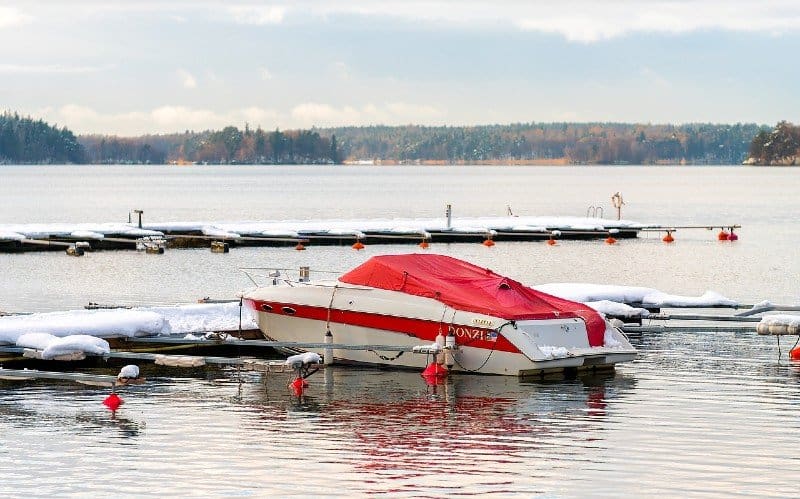
A boat cover is more than just an accessory. It’s a way of protecting your investment. Considering how much money a boat costs, you should want to do whatever you can to keep it in the best shape possible. When properly fitted, a boat cover does just that. Not every boater is convinced a boat cover is necessary. But take a look at exactly what a good quality boat cover can do.
- Protects against dust, dirt, and debris
- Prevents fading and damage from the sun’s harmful rays
- Keeps water and moisture away from your boat
- Prevents mold from forming
- Can keep animals from getting into your boat, and especially birds for making a mess on your boat
- It can also act as security for your boat by discouraging would-be vandals or thieves
The key to all of this is a well-fitted boat cover. Using any old boat cover won’t do. That’s why making your own boat cover to fit your boat specifically is one of the best things you can do.
How to Make Your Own Boat Cover

Making your own boat cover won’t just save you a lot of money. It will also ensure a perfect fit if it’s done the right way. The steps to make your own cover that are not as hard as you might think.
Measure the Boat: The first step towards making any decent boat cover is to know the exact size of your boat. Start by measuring the stern at its highest point. That could be the stern itself, or along any rails you may have. Write down the measurements on a rough sketch of your boat so that you’ll be able to refer to it later.
You can now move on to the windshield and measure the width and the height of its peak to the rub rail. After that measure the widest part of the bow and include the height of the rub rail if you have a railing there.
Get a full measurement from the bow rail to the stern rail. Make sure to cover every high point like railings, the windshield, and anything else. This ensures you’ll get a precise end to end measurement.
Double check all your measurements, just in case. When you record them remember that you don’t want a boat cover that fits too tight. Nor do you want a boat cover that’s too loose.
Buy Your Material: When most people talk about boat covers they use the word canvas. When you’re doing work making it, that’s called canvas work. In this instance, canvas doesn’t necessarily mean what you think. It doesn’t have to be that thick material that is literally canvas. Any kind of fabric or material can get the job done here if it’s light enough and strong enough.
One of the best places to get material for making a boat cover is from Sunbrella. Sunbrella sells a wide range of their own boat covers and bimini top. But they also supply the raw material that you can use to make your own boat cover.
Depending on your supplier, you could get Sunbrella acrylic fabric for around $24 per yard . This fabric is some of the best in the industry. It resists mold, water, and mildew. It also resists UV rays and it won’t stretch or shrink.
In order to sew your fabric, you need a special thread. This isn’t the kind of stuff you find at the local craft store. Use something called a V-69 polyester sailmaker thread. It’s high strength and it will not degrade in sunlight. It resists saltwater, mildew, and rough wear and tear. A 1,300 yard spool of it will cost you $13 .
A number 18 needle is recommended for sewing any three ounce to six ounce fabric. That includes the fabric that Sunbrella sells. You can get a pack of them pretty cheaply on Amazon. You want to make sure you have a number of spares because odds are you’ll break a few in your sewing machine.
If you’ve ever seen any professional tailors work, then you’ll know you need chalk. White chalk is good for marking fabric without permanently damaging it. Also, a solid pair of scissors to cut fabric will be very important. You may also want to pick up a stitch ripper to help fix any mistakes. Also, something called basting tape. Basting tape is a double-sided tape specifically used for canvas. It will allow you to precisely lineup and affix your fabric before sewing. This greatly cuts back on mistakes.

Cut Your Fabric: Now that you have everything you need and you can cut your fabric to size. Remember that you’re going to need some extra to stretch the cover around the sides of the boat. You also need room for ties to keep it tightly fit. Cut your panels to fit across the widest segments of the boat.
Stitch Your Panels: Overlap the fabric panels so they have about a 5/8 of an inch seam. Lay all the panels over your boat with this overlapping seam to ensure they fit. If the size and fit works out, you can use the basting tape to hold the seams where you’ve laid them out. At this point, you can use your sewing machine and stitch the fabric panels together.
Once you have the basic shape stitched together, place the stitched cover over the boat. Use your chalk to mark where you need to trim the edges down. Use your shears to cut it down to a reasonable size all the way around.
Set up Your Draw Cord: You should have left enough material around the edges to hem the edge. This will allow you to run a rope or draw cord around your cover.You’ll need to cut holes to allow the rope to come out. You should secure it with some large grommets. Alternately, you can fold the edges of the holes back and sew them to create a drawstring pocket.
Insert the Ropes: Make sure you have chosen a good quality, water resistant rope. Run it through the holes and leave a reasonable length for a drawstring at the end.
Cover the Boat: Now that everything is the right size and shape, send it over in the boat. If anything needs adjusting, now’s the time to do it.
Test the Ropes: At this point you can check to make sure you have enough rope so that you can pass it under your boat. kite securely to make sure it’s the way you want it to be. If everything looks good, you just made and secured your own boat cover.
Things to Remember
As you can see, the process of making a cover is not that hard. If you can use a sewing machine and measure materials, you can make a cover. The cost in materials versus what you have to pay for a custom cover is quite dramatic. You may have to hone your sewing skills first if you’re not comfortable sewing heavy material. Make sure you try a few scraps panels ahead of time to get the hang of it. Don’t panic if you break a needle, as it’s probably going to happen a few times.
My grandfather first took me fishing when I was too young to actually hold up a rod on my own. As an avid camper, hiker, and nature enthusiast I'm always looking for a new adventure.
Categories : nauticalknowhow
Urban Faria on September 6, 2020
Very, very interesting to me as I want to start a boat covering/canopy/cushion hobby as a retirement pastime.
Leave a Reply Cancel reply
Your email address will not be published. Required fields are marked *
Save my name, email, and website in this browser for the next time I comment.
More in nauticalknowhow

How to Tie a Boat to a Dock

How to Clean a Boat Cover

Everything You Need to Know About Your Boat’s Bilge Pump

4 Ways to Tie Your Boat Shoes

The People’s Poncho Review and Ratings

Oru Lake Kayak Review

What Is A Gunwale?

131 of the Best Hawaiian Boat Names

167 Patriotic Boat Names
About boatsafe.
Established in 1998, BoatSafe is your independent guide into the world of boating, fishing, and watersports. We provide expert insights and detailed guides to help you find products tailored to your needs and budget.
Contact Boatsafe
- Address: 4021 West Walnut Street. Rogers, AR 72756
- Phone: (479)339-4795
- Email: [email protected]
Site Navigation
- How We Test
- Corrections Policy
- Privacy Policy
- Terms & Conditions
- Editorial Policy
- Affiliate Disclosure
Our Reviews

All content is © Copyright 2024. All rights reserved.
- Skip to primary navigation
- Skip to main content
- Skip to primary sidebar

- Drawing And Sketching
- Free Crochet Patterns
- DIY Projects
- DIY Automotive
- DIY For Pets
- Kitchen organizing
- Tie Dye Projects
- Modern Footer
Home » DIY Projects
25 Homemade DIY Boat Cover Ideas You Can Make Easily
Published: Nov 27, 2021 · Modified: Oct 20, 2023 by Tijasar · This blog generates income via ads
There are so many benefits to making your own boat cover. It is economical, simple, environmentally friendly and the most important benefit, it will last longer. Most boat owners love their craft so much they don't want something that's cheaply made. Use your canvas more than once with these great homemade boat cover tips. A boat cover is an important accessory for your craft, but it can also be very expensive, especially if you want a good quality one. It’s not surprising, really – boat covers are made to withstand extreme weather conditions, and that means that they require a lot of tough materials. The fact that they can be custom-made means that you can have the perfect fit for your boat , which is also something that will save you money.
Homemade Boat Cover Ideas:

Below is a list of 25 Homemade Boat Cover Ideas you can DIY easily. Making your own boat cover definitely isn’t rocket science, but it does take time and effort. You will need to know how to sew, or at least have someone who can help you out with this part. Additionally, you will probably need some extra materials in order to make the cover water-resistant. However, if you are willing to make these investments in time and effort, there is no reason why you shouldn’t be able to make a fantastic custom boat cover for your craft at a fraction of the price that it would cost if you ordered one.
How To Make A Boat Cover

If you want to take care of your boat but don't want to shell out for a custom-made cover, it's possible to make your own. It may sound like a daunting prospect, but it can be much easier than you think. The blog post linked below will guide you through the process from start to finish, from picking out suitable materials to actually creating the cover itself.
In addition, the post explains how to stain and seal your cover so that it lasts as long as possible. If you're planning on making a cover as a gift for someone who loves spending time on the water, this is an especially handy tip!
Check More Details
How To Make A Power Boat Cover
Making a cover for your boat can be a big job and one that’s not always taken lightly. There are plenty of steps to follow when you’re putting one together, and it’s always important to make sure the cover is made right so it will do its job and protect your boat from the elements.
So if you need to make a cover for your boat, this video is definitely for you. It covers all the details of how to make a custom boat cover, with plenty of advice to help ensure it fits perfectly. And because it’s over an hour-long, you can be sure you’ll get everything you need to know to make a great cover.
Do-it-yourself Fashioning Canvas Covers For Your Boat

You can use any fabric for this project, but if you’re after a waterproof cover, then something like PVC would be the best option. The reason for this is that not only is PVC waterproof, but it’s also heavy-duty and durable.
Of course, there are other options too. You could use heavy-duty polythene sheeting or even a breathable canvas if you want a more flexible, lightweight cover. If you’re going to be using breathable fabric, you should consider using a good quality waterproofing agent to make sure that rainwater doesn’t get in under the cover.
You might also want to consider whether or not the type of boat that you have means that your choice of fabric needs to be fireproof. In most cases, it won’t matter, but if you have a wooden boat and need to ensure that no sparks from any fires above deck could get through and ignite anything below deck, then it may be worth making sure that you choose an appropriate fabric.
Best Boat Cover Support System
If you have a boat, then you are probably looking for the best DIY boat cover support system. It is always better to use covers instead of tarps to protect your boat from the elements. While there are many different ways to protect your boat, many people use systems that are easy to build with common materials. If you are looking for a great DIY project and want to make a simple DIY boat cover support system, then continue reading this article and learn how you can make one for your own boat.
Making A New Boat Cover For My Skerry
There are a number of reasons why a boat owner may want to make a new cover for a boat. The cover may have become worn and faded from being in the sun for so long, or perhaps it has been damaged by weather, pests, or other factors. Whatever the reason, making a new cover is not that difficult. In fact, because there are so many options when it comes to fabrics and materials, you can use this project as an opportunity to add your own personal touch to your boat.
The first thing you'll need to do is purchase the materials you'll need for making the cover. If you have a good sewing machine at home, you may only need thread and a few other items. If you don't have a sewing machine, consider purchasing one or taking the cover to a professional seamstress in order to ensure that the job is done correctly, or you choose to purchase a sewing machine, make sure that it will be able to handle the type of fabric that will be used for the project. You'll also need measuring equipment such as a tape measure and possibly even some sewing patterns if you're unfamiliar with how covers are made.
Boat Cover DIY
Once you’ve got your tarp, you’re going to want to try and find a way to cut out some of the material. This is something that will take a little bit of work, but it’s not particularly difficult. You can use either your sewing machine or just a sharp pair of scissors if you don’t have one handy.
You simply need to cut out one half of the tarp, so that it can be folded over on itself so that the edges are touching each other. If you’ve used a larger tarp than specified, then you can even cut out two halves so that they overlap by about six inches on either side.
The next step is to figure out how best to attach the tarp to your boat. For this particular design, we’re going to go with straps, but there are plenty of other options available to help keep your boat covered – this is something that will really depend on your personal preferences and how much time you want to spend on the project.
How To Make A Powerboat Cover

A boat cover is a must-have for any powerboat owner. Whether you live in a place that gets regular rain, or you want to protect your investment from the sun and potential thieves, a quality boat cover is key. A commercial one can be costly, but it doesn't have to be — this homemade cover looks great and is easy to make.
The post is an excellent resource for anyone looking to make their own boat covers. It includes several helpful tips and techniques for making your cover as waterproof as possible, as well as plenty of detailed photos showing how to do it. The author also includes a video showing the process at work, making it easy for anyone to follow along with the project.
How To Make Sunbrella Dinghy Cover To Protect PVC From Sun UV
Using Sunbrella, this PVC dinghy cover can be made for around $400. It’s not the only material that will work, but it’s one of the best. It can withstand UV damage and is also easy to clean. The main idea behind this project is to use a tarp as the base material and then apply Sunbrella over it using sewing techniques. This covers up all the stitching so that you don’t see any ugly stitching, which would detract from the overall look of your dinghy. By applying Sunbrella to it, it looks like an expensive cover instead of an affordable one.
The tarp protects the PVC from UV rays and means you don’t have to replace it as often as you would if there were no tarp at all. It also protects the PVC from the elements—rain, snow, ice, and more—in a way a normal cover wouldn’t necessarily do.

There are many benefits to making a boat cover for your boat rather than buying one. Among the benefits of making your own boat cover are that you can save money and tailor it to the size and shape of your boat. However, to make a cover that will be an effective and durable solution, you need to follow some basic guidelines and employ some advanced techniques. You can also make a cover to provide protection from things like sun damage and keep the microorganisms at bay. These steps will show you how to make a cover for your boat.
Easy Cheap Boat Cover Support Frame DIY
PVC piping is the key to this design. The cover is constructed of three pieces, each supporting the other. The first piece is a back panel that runs along the top of your boat. The second piece is a hoop at the front, which raises the cover above the bow area. And the third piece is an "S" curve that supports both of these pieces at their junction point.
The center of this S curve sits directly over your boat’s motor, but it doesn’t have to be exact to work well. As long as you have enough material to keep rainwater from pooling on top of your boat’s motor, you’re good to go.
This type of frame can be easily made with PVC piping that’s cut into appropriately-sized lengths using a hacksaw or PVC cutter. Some larger hardware stores may even offer services for making custom cuts for free if you don’t have access to either tool at home.
DIY Boat Cover Support System

This boat cover support system was built using a couple of metal beams, some large-diameter steel pipes, clamps, and fittings. It’s perfect for use with inflatables, especially those that are permanently installed on boats that don’t have hardpoints for mast or bowsprits to be attached to.
You basically just need to find the right materials, measure them up, and then put them together. We’re not going to go into much detail about how it’s done here, but if you want more information, head over to the website listed below where you will find the instructions in full, along with some diagrams.
DIY Boat Cover
Here's a DIY project that is both ingenious in its simplicity and in its utility. Kevin, who posted the video on YouTube, explains that he was having trouble keeping his duck-hunting boat dry when he used a tarp to cover it. He tried using stakes to keep the edges down, but they kept blowing away in the wind; he then decided to rig up this DIY frame to create a ridge, they constructed it from PVC pipe and chicken wire, and it worked perfectly.
This inventive solution is a great example of how one man's trash can be another man's treasure. The materials needed for this project were readily available at his local hardware store, and once he had them in hand, the construction took him less than an hour. The cost of the materials was minimal, but the benefit was huge – a fully functional custom-fitted boat cover that will last for years to come.
Make A Canvas Sailboat Cover I Made It At Techshop

Sailing is a great sport, but it can be very expensive. For example, buying a used sailboat might save you some money, but the costs of refurbishing it can really add up. On the other hand, making your own canvas sailboat cover can save you money and help you hunt for bargains in your search for the perfect boat. The only downside is that it requires some sewing skills, so if you’re not handy with a needle and thread, this one will be tough. However, if you are handy with a needle and thread, this tutorial gives clear instructions to follow in order to make your canvas sailboat covers fit like a glove.
How To Fix A Boat Cover That Gets Filled With Water
Water pooling on your boat cover is not only an eyesore, but it can be damaging to your boat itself. A lot of water can pool on the cover, potentially causing your boat to become warped. What if there was a way to solve this problem? Well, there is!
This video suggests that you can fix this problem by creating a small hole in the boat cover which allows the water to drain. This makes so much sense! Especially since water pooling on the cover is usually caused by rainwater collecting on top of it. So draining it is the obvious solution! We’re sure this will help many boaters out there with this issue. Thanks for sharing this simple solution with us!
Small Boat Cover Frame

Many boat owners have had to deal with water pooling inside their boat after a snowfall, even though the cover appears to fit snugly. This problem occurs because water is collected at the base of the cover, where it runs down the hull and into the boat.
If you have a painted hull, water can cause damage by running onto the paint and into seams. It can also form pools that are difficult to remove without damaging the hull. The solution is to install a small-boat cover frame that channels water away from the boat.
A small-boat cover frame is an easy DIY project that anyone can build using readily available materials. Best of all, it's not only functional but also adds a decorative touch to an otherwise plain cover, as well as makes it easier to open and close.
How To Build A Tarp Frame For A Boat
Thinking about building your own boat cover? This video tutorial will show you how to use a tarp to make a custom cover for your boat. You'll need some rope or cordage, a tarp, and some sticks. That's it!
The tutor in this video seems to have quite a dry sense of humor, but he also has lots of great ideas about how to build a frame for your boat cover. So if you want to find out how to do it – and you don’t mind a joke or two along the way – this is a video you should enjoy.
Canvas Repair Tips

The problem with old canvas is that it can be really hard to find a replacement. Because of this, you might as well try and repair the one you already have. It’s actually not as hard as you might think. There are basically two ways to approach this: patching and sewing. Patching is a lot easier and can be done really quickly, but it will leave a visible scar on the canvas. If you want to save your canvas and turn it into something that can last another season or two, then you’re going to have to do some sewing.
Before you get started, though, there are a couple of things that you need to look out for because they can seriously affect the quality of your repair. First of all, be sure that the canvas isn’t just torn or worn out, but that it actually has holes in it, otherwise your repair won’t hold up all too long. Also, if possible, keep an eye out for any rot because these areas can get worse over time if left unattended.
How To Make A Trailerable Boat Cover
Trailerable boat covers are a lot simpler to make than you might think. This video shows you how to make a trailerable boat cover that will fit any boat, and it can be done using a sewing machine for a couple of hundred bucks. The biggest advantage of a trailerable cover is that it's going to be much easier to store and transport your boat with a trailerable cover over a non-trailerable one. It's really important to take care of your boat, and the best way to do so is to make sure it stays as dry as possible.
Trailerable covers are also very portable, which means you can take them with you wherever you go. They're also very easy to put on and take off, so whenever you're done using the boat, just throw the cover on and wrap everything up nice and tight until the next time you want to use it.
How To Make A Homemade Pontoon Boat Cover Support System

This plan is for a cover that goes over the top of the Pontoon boat . It’s a little more expensive than the other one, but you might find it worth it if your boat will be going out of storage for a few months before you put it to use again.
The DIY boat cover support system includes a step-by-step list so you can easily follow along and make your own cover frame. It also includes pictures to help with the process as well as a materials list so you know what you need to buy at the store. There’s even a video tutorial that shows how to build the whole thing if that’s easier for you or if you have trouble following written instructions.
Cheap And Easy Boat Cover Frame – How To DIY
This video shows you how to build this DIY boat cover frame so you can store your cover off the boat whenever you want. The instructions are easy to follow and the design is very simple, so it doesn’t take much time or money to make it. The best thing about this frame is that it’s easy to adjust, so you can use it for different types of boats. The frame is made of 2 by 4 boards and 1 by 4 boards, with some wooden dowels to connect them all together.
The side panels are made of 2 by 2 boards, and the top bar has a few more 2 by 2 boards. You can make these cuts with a circular saw, but if you don’t have one at home you can use a jigsaw instead. The most challenging part is probably gluing all the pieces together, as they have to match perfectly for the frame to work properly. But if you take your time and do this right this shouldn’t be a problem.
Tarpaulin For Your Yacht A Low-Cost Alternative

This blog post gives an interesting insight into the various options for yacht storage, but it’s the DIY tarpaulin that really caught our eye. It’s certainly a viable option if you’re looking to keep costs down, and the fact that you should only need a few basic tools suggests this could be a great project for those of us who are handy with a sewing machine. A lot of people will tell you that boat storage is all about location, location, location – which is true if you can get a space on a mooring. However, even if you have the space to do this, it’s important to remember that your boat needs shelter from the elements and other potential hazards.
For example, many boats are left in the water over winter to avoid the hassle of getting them out of the water and into storage – but this can lead to problems if there are strong winds or heavy snow falling from overhead. Even if your boat is safely moored up, it still needs protection from falling debris.
Make Your Own Winter Boat Cover
Boat covers can be a pretty big investment if you’re not careful. If you’re the DIY type, you can easily save a ton of money by making your own winter boat cover. This video shows you how to go about doing just that. It’s a little long, but it’s worth watching all the way through if this is something you’ve been thinking about doing yourself.
In this tutorial, they show you how to make a winter boat cover for a 23-foot boat from scratch. It’s also very simple and easy to follow, so if you have access to a sewing machine then there’s no reason why you shouldn’t be able to make one for yourself.
Secret Tarp Hacks
If you don't have a tarp for your boat, or if the one you have is too small, this video will show you how to build your own. You'll learn how to choose the right materials, how to cut them to size, and how to secure everything. The video explains that the way you build your tarp depends on whether you're working on a hard boat or a softie. Hardboard is a boat with a rigid hull, like a canoe or kayak. A softie is made of fabric stretched over a frame, like an inflatable raft.
It's important to use the right kind of tarp. The video recommends using 100% nylon material because it has a waterproof coating. It also says that a 1″ nylon tarp works best for boats under 16 feet, while a 2″ nylon tarp is better for larger boats.
Boat Cover – Adventures On The Club

There are a few different reasons why people might want to consider using a DIY boat cover. The primary reason, of course, is cost – shrink wrap can be expensive, and it can be difficult to find a source for it in some areas. But there are other reasons as well – a DIY boat cover will offer a more customized fit for your boat, and it also means that you don't have to deal with the weight of hundreds of pounds of cover on your boat all year.
It's really not difficult to create a DIY boat cover – all you need is a tarp and some Bungie cords, and you're ready to go. The tarp needs to be large enough to completely cover your boat deck and cockpit, as well as extend down the sides enough to reach the waterline when fully stretched out. You'll probably want to make sure that the tarp is taped or stitched around the edges, and that all of the seams are sealed as well – this will help keep water from leaking in through those cracks and seams.
adventuresontheclub
DIY Retractable Boat Cover!
The primary advantage of this solution is its cost. The entire project, including the cover itself and the retractable mechanism, cost only about $125. And compared to the hundreds of dollars that many commercial boats cover the cost, even if you don't have access to free trees or an old tarp, this is a much more affordable solution. There are other advantages too, though. Versatility is one big one — the DIY boat cover can be used for not just protecting the boat from pollen and debris but also as a makeshift shelter for outdoor activities like camping. Another advantage is the ease of use — it can be raised or lowered with just one hand.
While the video above focuses on building a retractable cover for a dive boat, there's no reason why you can't modify this tutorial so it works for other types of boats as well. Check out the full video below to learn more about this unique DIY boat cover!
More DIY Projects

Sharing is caring!
- Pinterest 7
5 Boat Cover Support Ideas for Your DIY Project
If you’re looking to build a homemade boat cover, you’ve found the right spot. There are so many options out there to create a custom project, starting with the different types of building materials and the various styles of structures you can build when you design your own. In this post, we present boat cover support ideas to inspire your project and give you information about the best building materials to do it.
Whether you are an experienced DIYer or a newbie, get ready to find out more about the various ways to create a project that’s accessible, using minimal tools!
1. Klaas’ steel tubes DIY boat cover
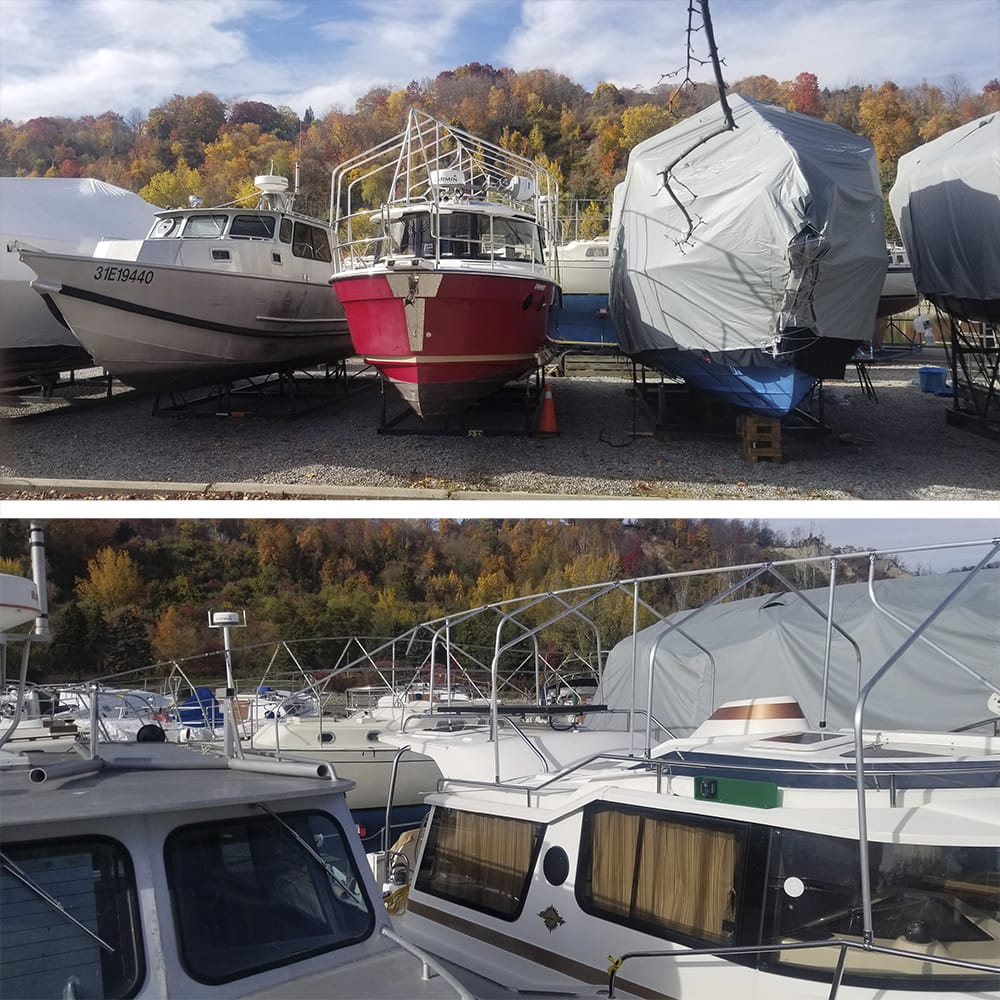
When you build with tinktube, there are always 2 options:
1. Using tinktube’s pipes and connectors: These two materials are designed to work together. They offer the best strength once assembled, resulting in sturdy and resistant structures.
2. Using tinktube’s connectors with other types of pipes, like 3/4 in. EMT conduit: In this case, you’ll have to use adaptors. They are sold online with the connectors. You have to choose this specific option when you add the connectors to your cart .
Klaas built his own boat cover support system with one-inch gauge aluminum pipes and tinktube’s connectors, using adaptors as shims so the connectors would be compatible with the aluminum pipes.
2. Boat cover support system
Barry and Cindy Robison are experienced DIYers & creators of this inspiring project. They welded their DIY boat cover, but you could practically build the same design without welding. How? With the tinktube system.
Creating the same angles and the overall shape of the structure is possible: all you have to do is choose the right connectors and draft a plan ahead to plan how many tubes you’ll need!
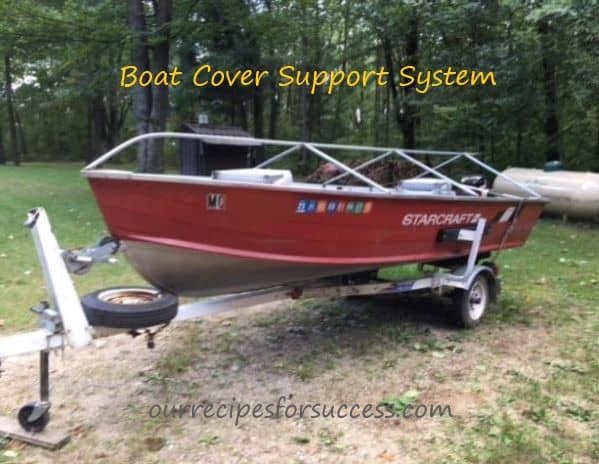
3. Pontoon boat cover DIY

Pontoons are the perfect boats for family and friends gatherings. You own a pontoon boat? You’ll be able to protect your deck and whatever it accommodates – lounge area, stand-up bar or any other type of set-up – with a homemade boat cover.
Again, building your project with steel tubes will enhance its sturdiness and durability. You can also make it easily removable too!
4. Arch support system for boat covers
Simple yet efficient, this design will give you optimal strength when built with steel tubes instead of PVC pipes. And guess what? You can easily bend the tubes without special tools – many DIYers have done it before.
In fact, one of our clients named Ryan explained his process like so: “To bend the tubes, I built a jig out of plywood. I cut two equal semicircles of 1/2” plywood slightly smaller than the radius of the bend I needed, and two more semicircles with a radius an inch larger.
I sandwiched the two smaller semicircles between the two larger ones. In this way, there is 1″ X 1″ groove that the tinktube can sit in. I then fixed the tube at one end using clamps and bent it around the semicircle by hand.”

5. Boat cover support pole

This example shows a simple way to keep the inside of your boat dry and clean. Using tinktube’s pipes and structural anchors to stabilize the poles at both ends, all you’ll have to do is cut the tubes at the desired length and pop the anchor in with a rubber mallet.
Important note: Once fixed to the tube, the anchor will be incredibly difficult to remove due to its design.
PVC alternative to build your boat cover frame
Are you considering the benefits of building a PVC boat cover support instead of using steel tubing?
If you’re already sold on PVC for your DIY projects, it’s your call -we’re not here to tell you what to do! But we’d still like to point out that, unlike your favorite building material, steel pipes offer impressive durability. Not only is the material more resistant, but it will also be reusable for other projects (you’ll be able to deconstruct your steel pipe boat cover support to create something else with your building material if you ever need to, instead of throwing it away). It is therefore more budget-friendly AND it reduces your environmental footprint!
All aboard: your homemade boat cover DIY sets sail now!
Whether you own a pontoon, a speed boat or a canoe, we hope you found inspiring ideas to protect your boat from the rain and the snow! If you have questions while planning your project, drafting your plans or shopping for tubes and connectors, schedule a call with Esteban . He’ll be able to give you useful advice to make your boat cover support project as successful as possible!
Looking for more DIY project inspirations? Check out the clever ideas below!

Poster stands by Alexander
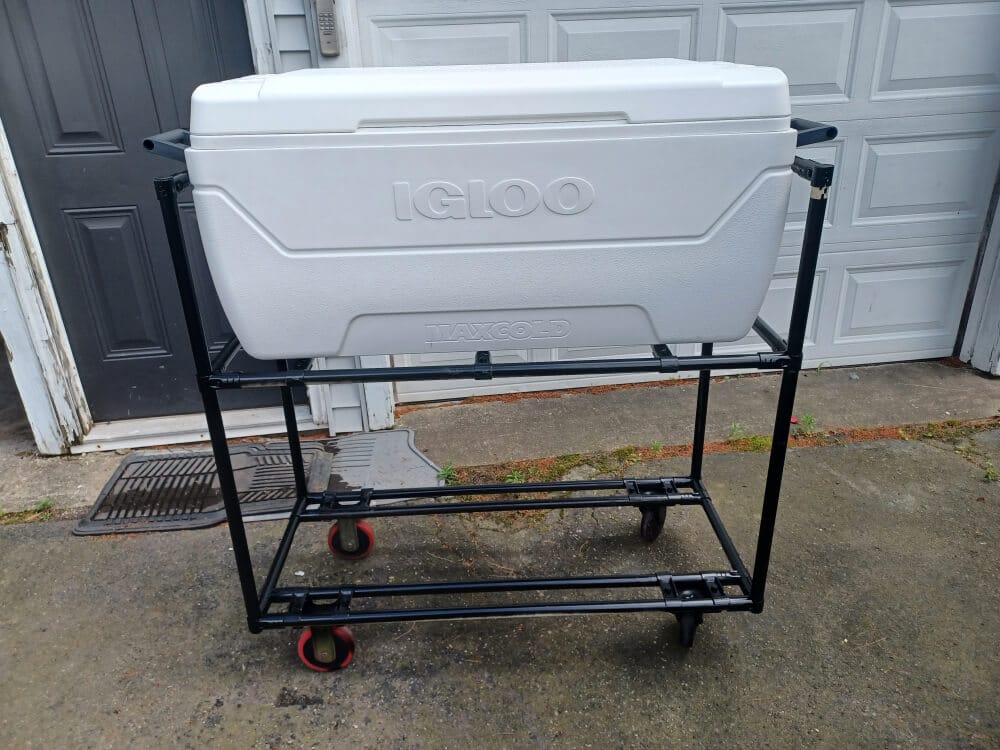
Customized cooler stand by Ed
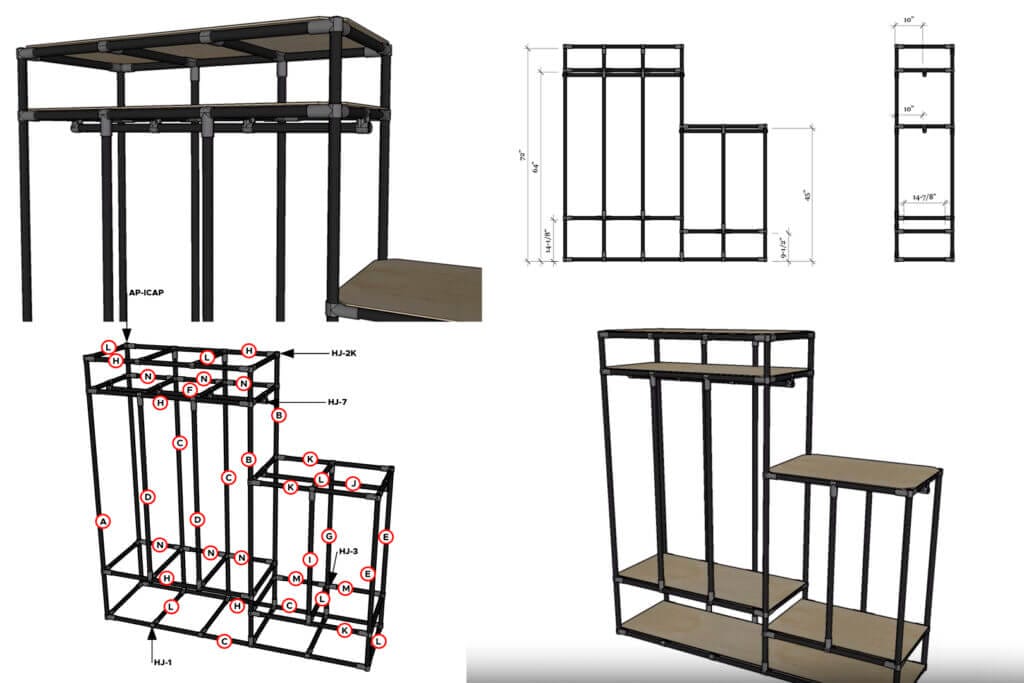
DIY Closet Organizer: Free and Easy Plan for Custom Closet Organization

DIY Hammock Stand Plans: Your Ticket to Relaxation Paradise

Golf simulator by Noel
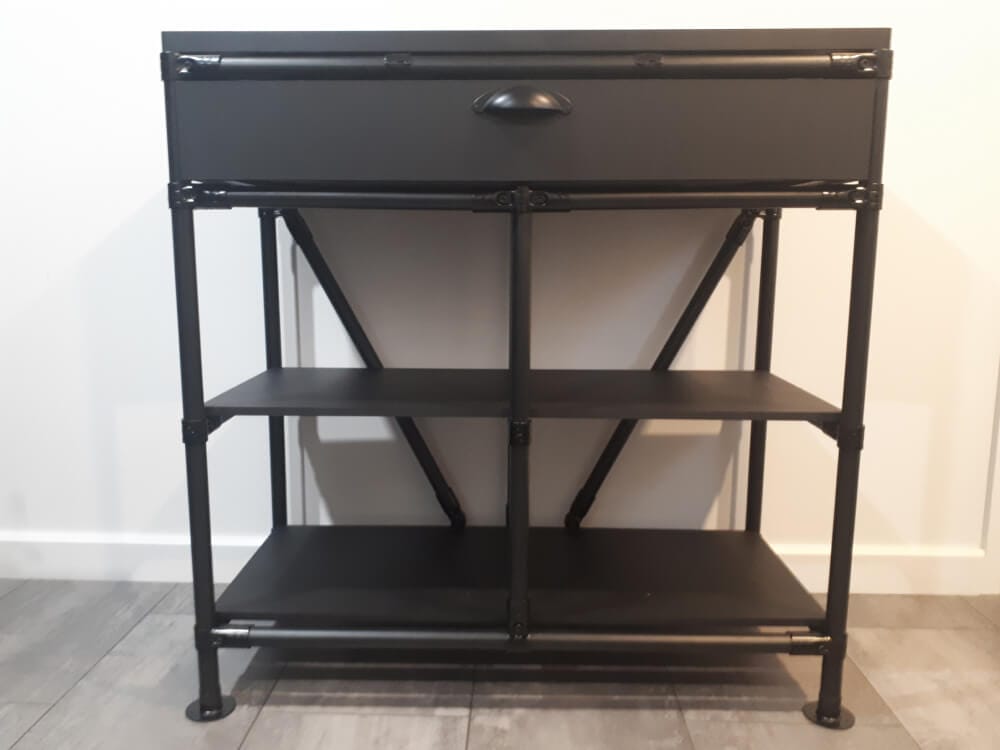
Working desk and shelves constructed by Daniel
About the author, éloïse sirois, leave a comment cancel reply.
You must be logged in to post a comment.
Got more questions? Schedule a 15 minute call with Esteban!
Or visit our FAQ and Tutorials

Share your project and get 10% !
Our team is always looking for new project ideas to share in the DIY world!
Share pictures of your projects with us and we’ll send you a 10% coupon code to use on your next purchase!

VIDEO
COMMENTS
If you want to make your own cover from scratch, we also include a full materials list so you can piece it together yourself. Each Sail Cover Kit also comes with step-by-step written instructions that are a great companion piece to this video. Ordering a Sail Cover Kit - 0:38 min. Cutting Patterns - 1:50 min. Applying Sailrite Logo - 5:04 ...
Measuring & Using Fabric Calculator - 1:35 min. Patterning Boat - 9:54 min. Cutting & Basting Fabric Panels - 25:30 min. Sewing Panels Together - 33:31 min. Cutting Fabric to Size - 45:12 min. Marking Pleats, Shrouds & Other Exiting Points - 52:20 min. Creating Skirt - 58:56 min.
Sailrite Sail Cover Kits include a #10 YKK Vislon Zipper along the forward edge of the cover (along the mast). The Sunbrella Marine Grade fabric is fashioned...
With a Sail Cover Kit from Sailrite®, it's never been easier to DIY your own, and our kits include all the materials you need, minus tools, to sew a sail cover. We provide detailed written instructions and a streaming online video that shows you the step-by-step construction process. Our kits come with the pattern pre-plotted, so all you ...
Protect your boat in the off season with a well-made boat cover that you can use over and over again. Our in-depth tutorial will show you every step of the p...
Sew a reinforcement under the middle of the cover. This will be used to hold the cover up using a halyard so that water will flow off of it and not puddle on the boat. Sew a small piece of webbing onto the top in this area to clip the halyard too. Sew a small piece of velcro to the strip going around the mast.
http://www.sailrite.com/Building-a-Sail-Cover-Online-Streaming-Video This is a video shows how to build a sail cover from the Sailrite sail cover kit. Each a...
This DIY boat cover is well worth the time and effort. Sailrite makes it easy to DIY a winter boat cover.Our free how-to video features thorough, step-by-step instructions on how to measure, pattern, cut and sew your cover. A complete materials and tools list makes it easy to order exactly what you need to get the job done.
Reasons Not to Shrink Wrap Your Boat: A yearly expense. Shrink wrap will cost you money every year versus the initial cost to make a cover that will last for years, saving you hundreds of dollars in the long run. Moisture buildup and ventilation issues. Shrink wrap traps moisture under the plastic and could cause mold and mildew damage.
With our detailed, video instructions you can create a sleek, fitted cover for your lateen rig sailboat. Our cover features a zippered boot to allow the mast to come through the cover and a pocket at the transom to accommodate the spars, which are typically laid on the deck when stored. The cover also has shock cord around the perimeter to keep ...
Cut the fabric: Use the measurements you took to cut the fabric for the winter boat cover. Use a sharp pair of scissors or a rotary cutter to ensure clean cuts. Sew the panels together: Sew the panels together using a sewing machine or by hand. Use a heavy-duty thread and a strong stitch to ensure durability.
Steps in making a DIY frame from PVC pipes. First, measure your boat to determine the size of the frame you need. Cut the PVC pipes to the appropriate length using a tubing cutter. Use elbows and connectors to join the pipes together to create the frame. Drill holes in the pipes where you want to attach the cover.
Sometimes the simplest ideas are best, and this video is the proof. Great job, we enjoyed this one! 15. DIY: Small Boat Cover Frame - Bound to Journal. This blog recounts a common problem that many boat owners probably recognize - namely, water pooling inside the boat after snow or rain due to the cover sagging.
Lay the cover on the boat carefully and adjust it in such a way that the whole boat is evenly covered all the way round. Step 8 - Pass the Ropes or Drawstring Beneath and Knot. Make sure you have enough excess rope or drawstring to pass the ends beneath the boat. Tie knots at regular intervals by pulling carefully to stretch the cover well ...
Take the cover back inside and sew in any pleats, darts, or folds you pinned in. Fold the edge in and pin it in place to create a hem, then sew a double seam all the way around. Fit the cover over the boat and make adjustments as needed. You may want to add wide, heavy-duty elastic in some areas, such as around the bow and along the stern, to ...
This is a breathable material that helps combat mold, UV rays, water, and mildew. It doesn't shrink or stretch, and yet it is fairly pliable, which makes handling it easier during the sewing process. Best of all, for beginners, both sides are identical so you don't have to worry about the "inside" and the "outside.".
Insert the Ropes: Make sure you have chosen a good quality, water resistant rope. Run it through the holes and leave a reasonable length for a drawstring at the end. Cover the Boat: Now that everything is the right size and shape, send it over in the boat. If anything needs adjusting, now's the time to do it.
boat cover diy pt.1 This is just to shed water and heat while it's sitting on land or at anchor. check the next vids for more info! comment and or subscribe!!
Homemade Boat Cover Ideas: Below is a list of 25 Homemade Boat Cover Ideas you can DIY easily. Making your own boat cover definitely isn't rocket science, but it does take time and effort. You will need to know how to sew, or at least have someone who can help you out with this part.
Inexpensive boat cover frame that will hold up against heavy snow. On top I put the thickest, heaviest 16 mil, 10 foot by 20 foot tarp I could find on Amazon...
1. Klaas' steel tubes DIY boat cover. When you build with tinktube, there are always 2 options: 1. Using tinktube's pipes and connectors: These two materials are designed to work together. They offer the best strength once assembled, resulting in sturdy and resistant structures. 2.
In this video we be building a trailering boat cover for a power boat. In order to quickly complete the project we will sew panels of fabric together then pa...
How to Make a Power Boat Cover Video provides step-by-step instructions for sewing a custom cover for your power boat. Learn how to create your own great fit...